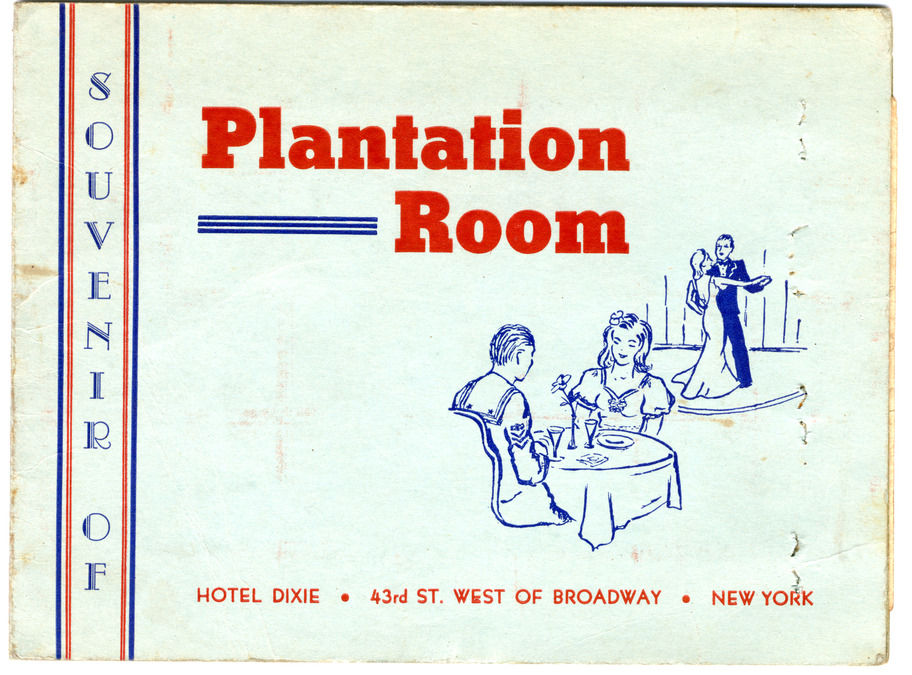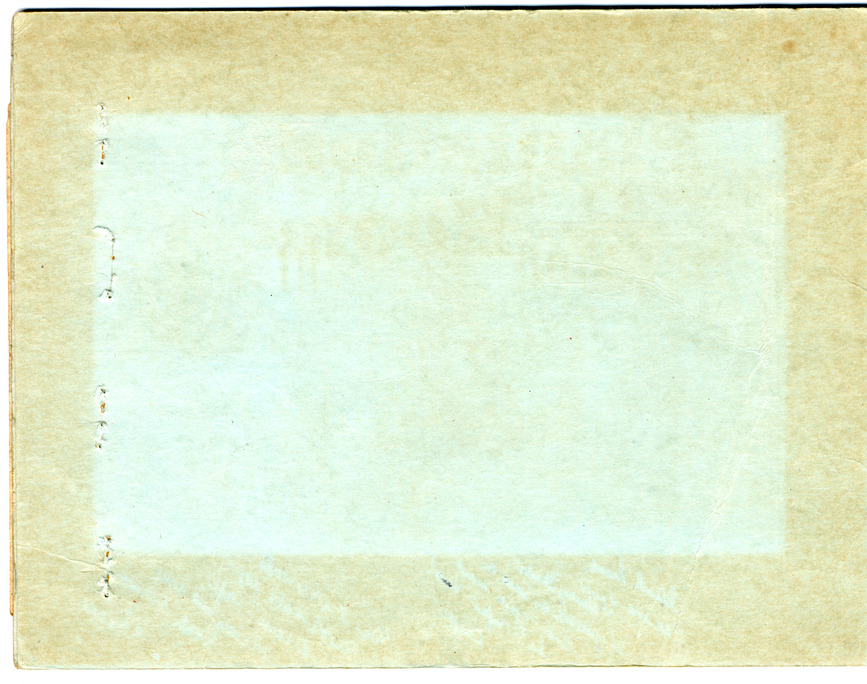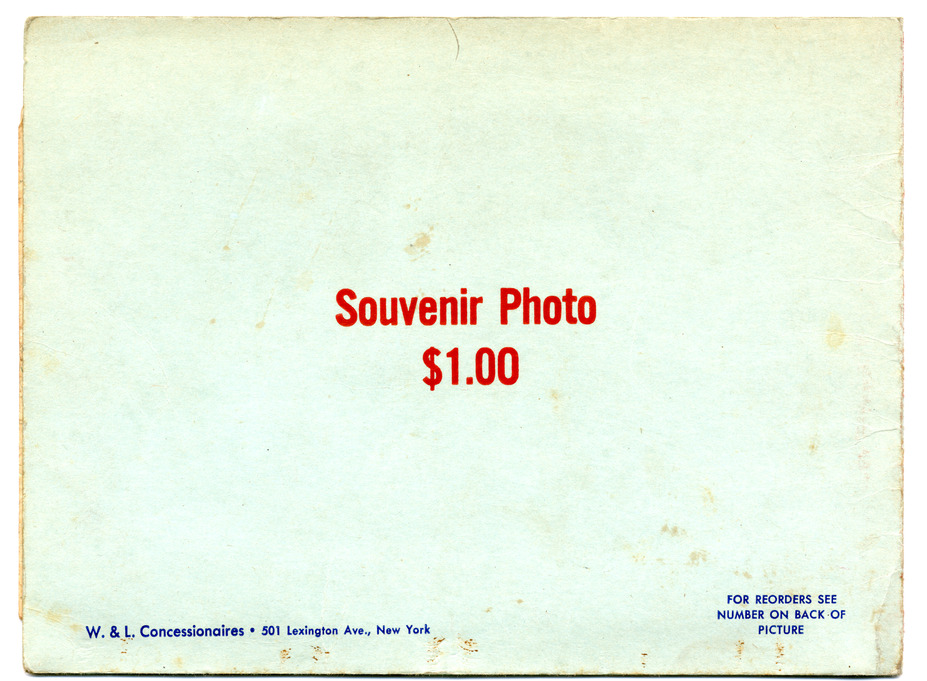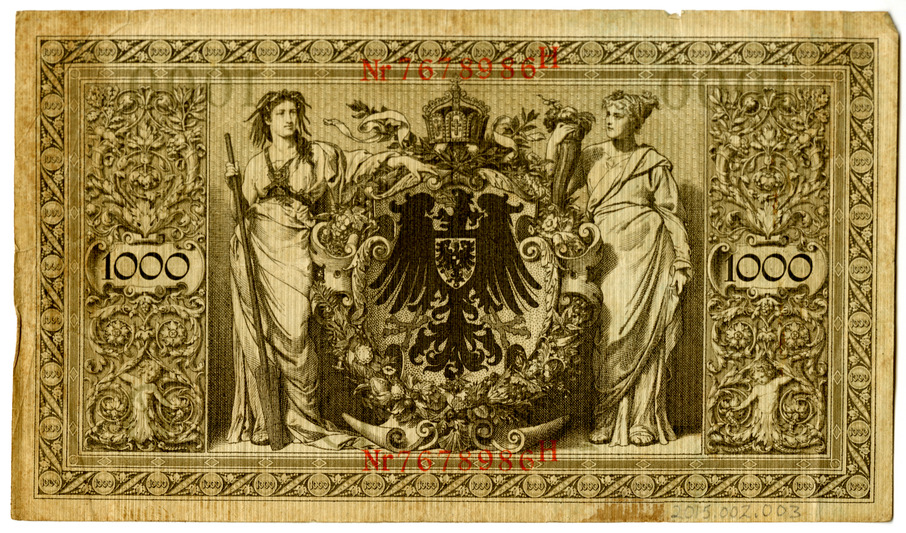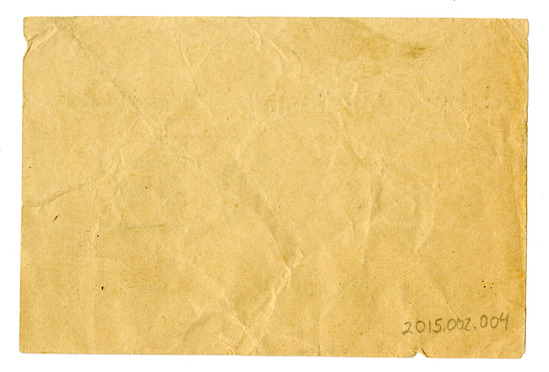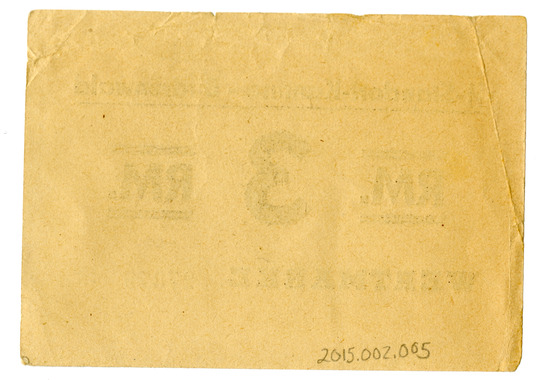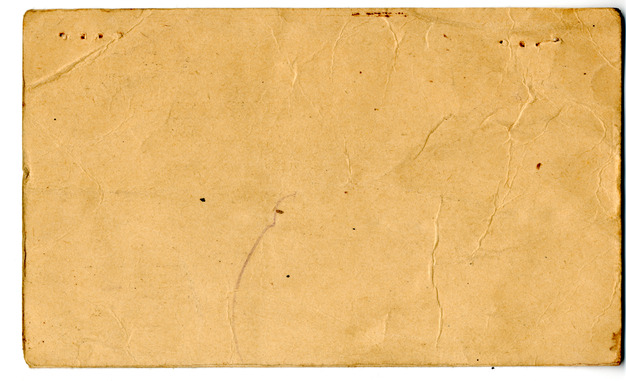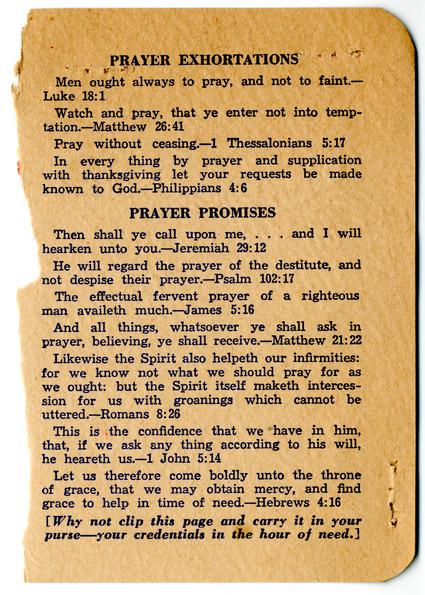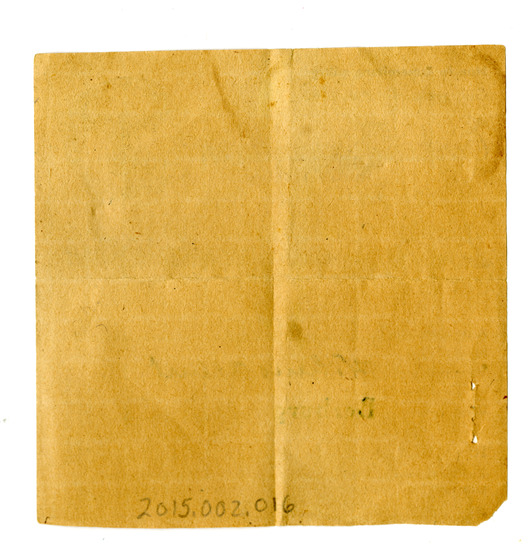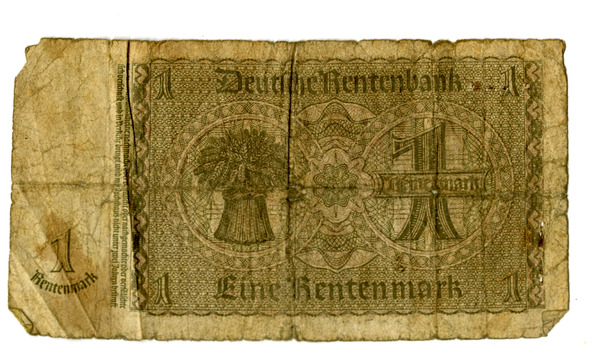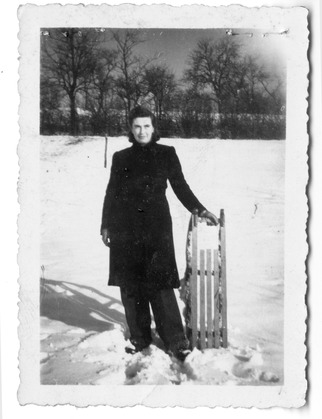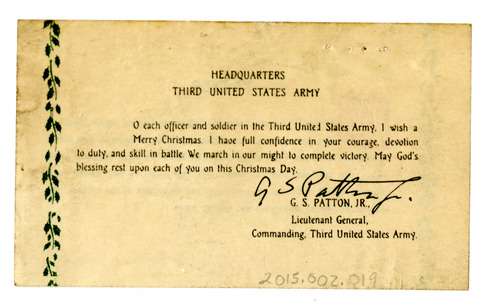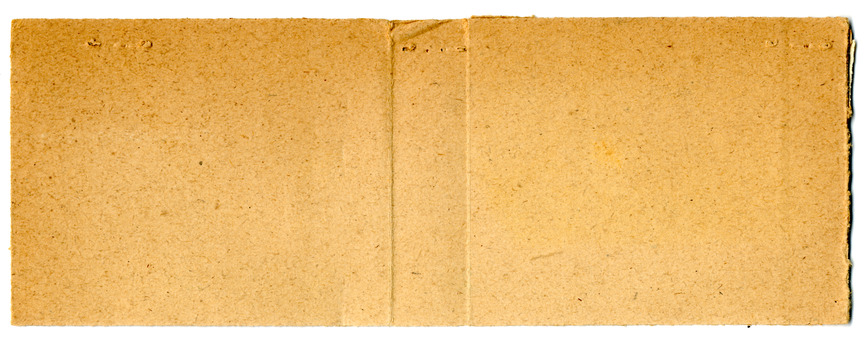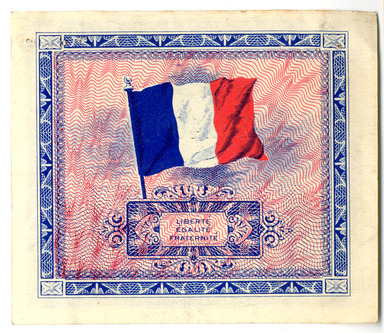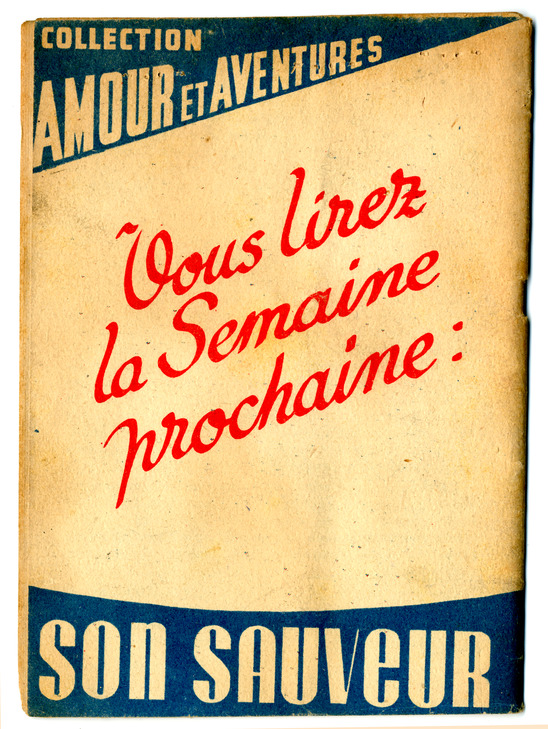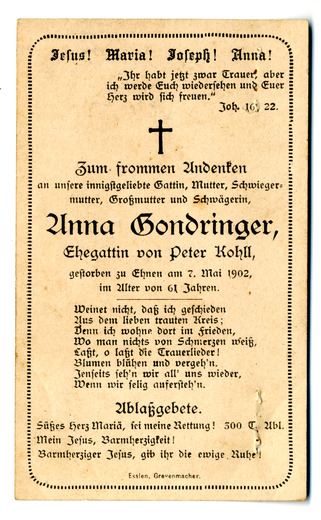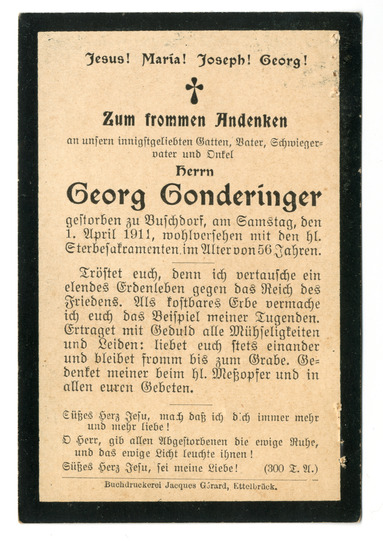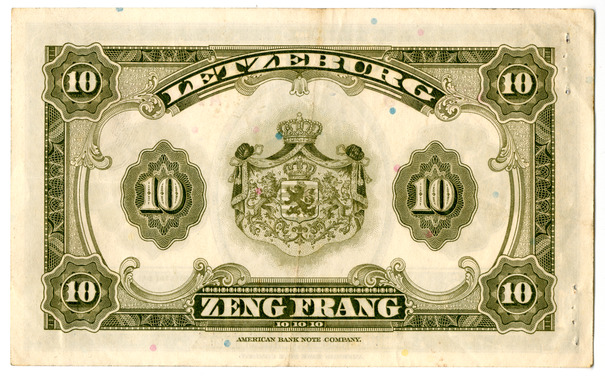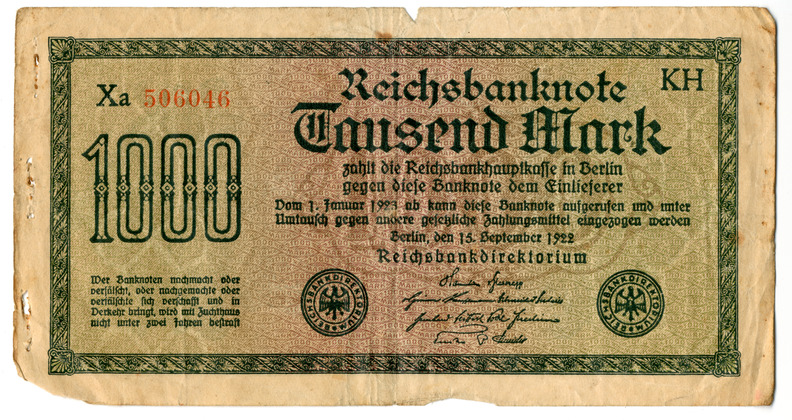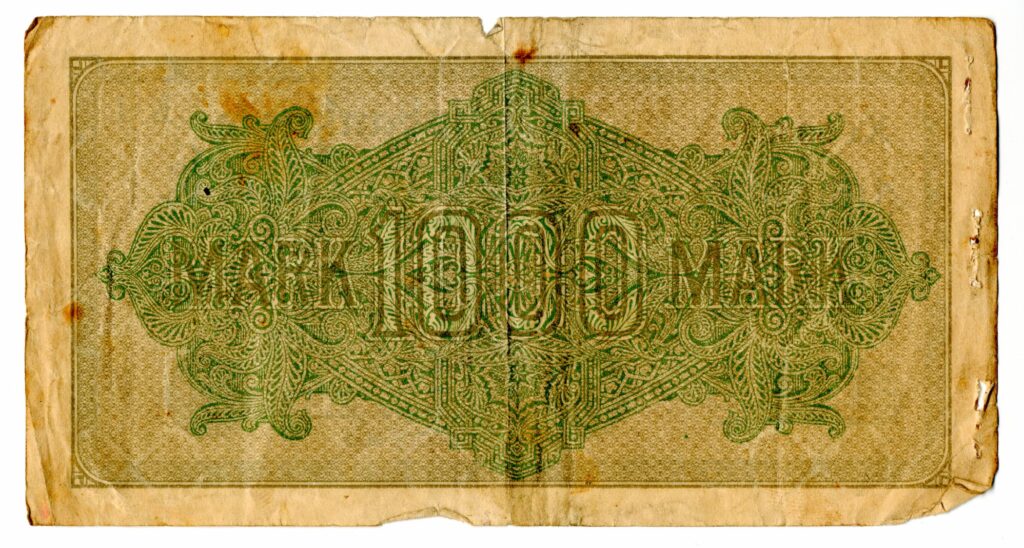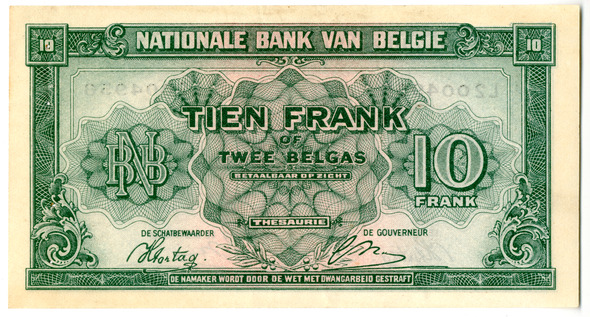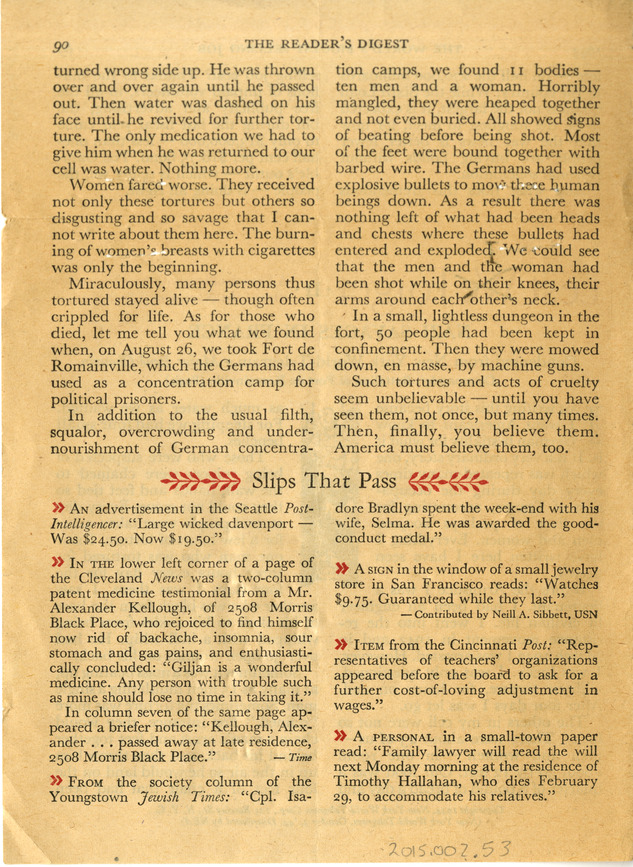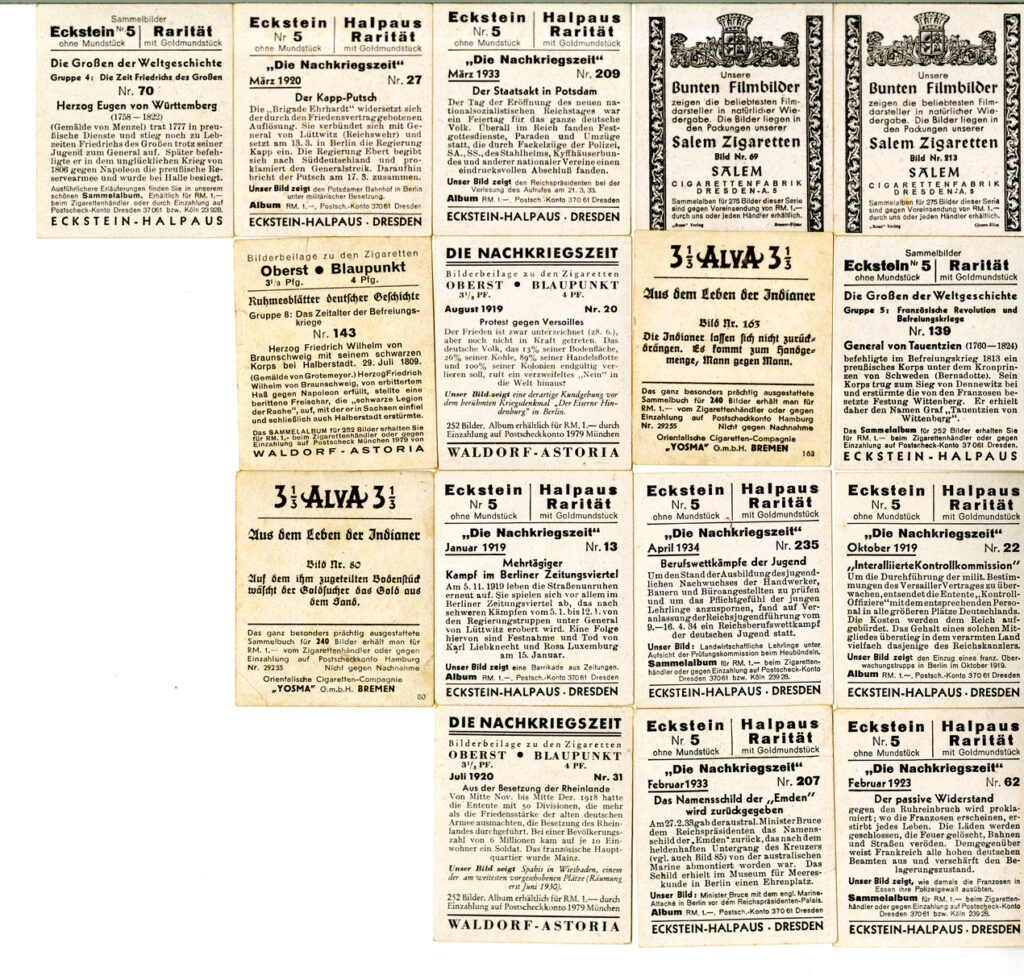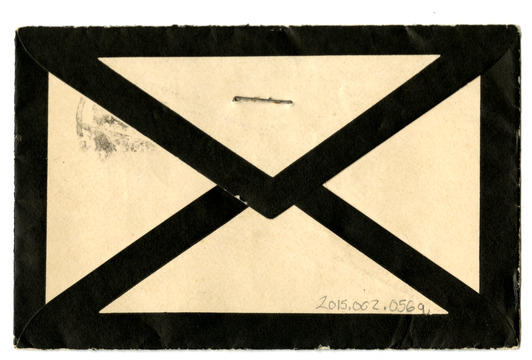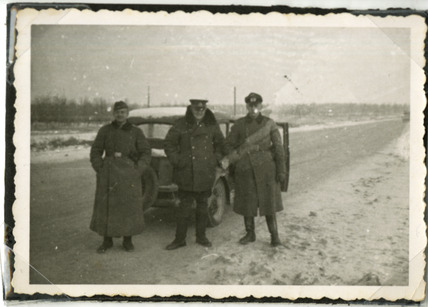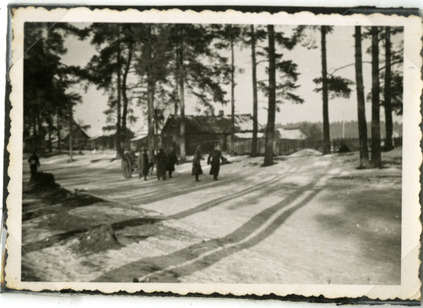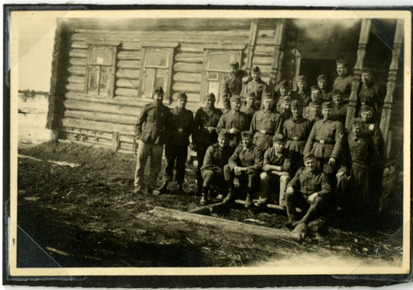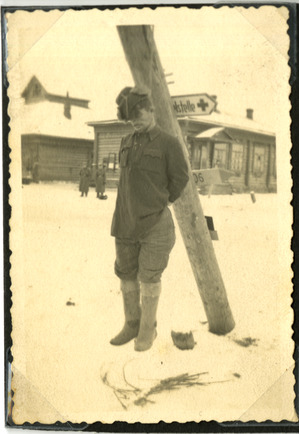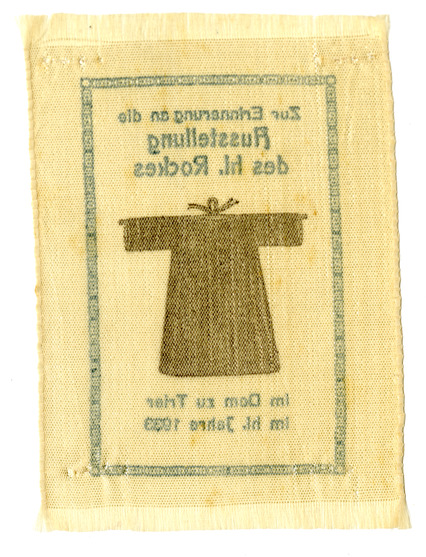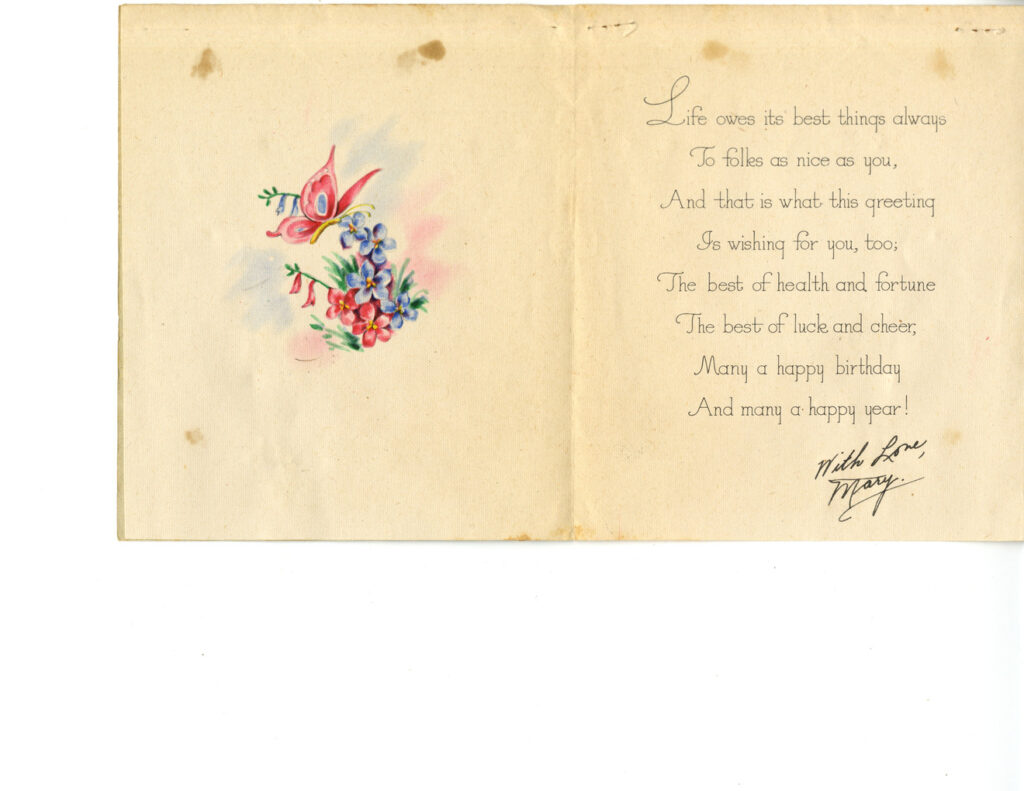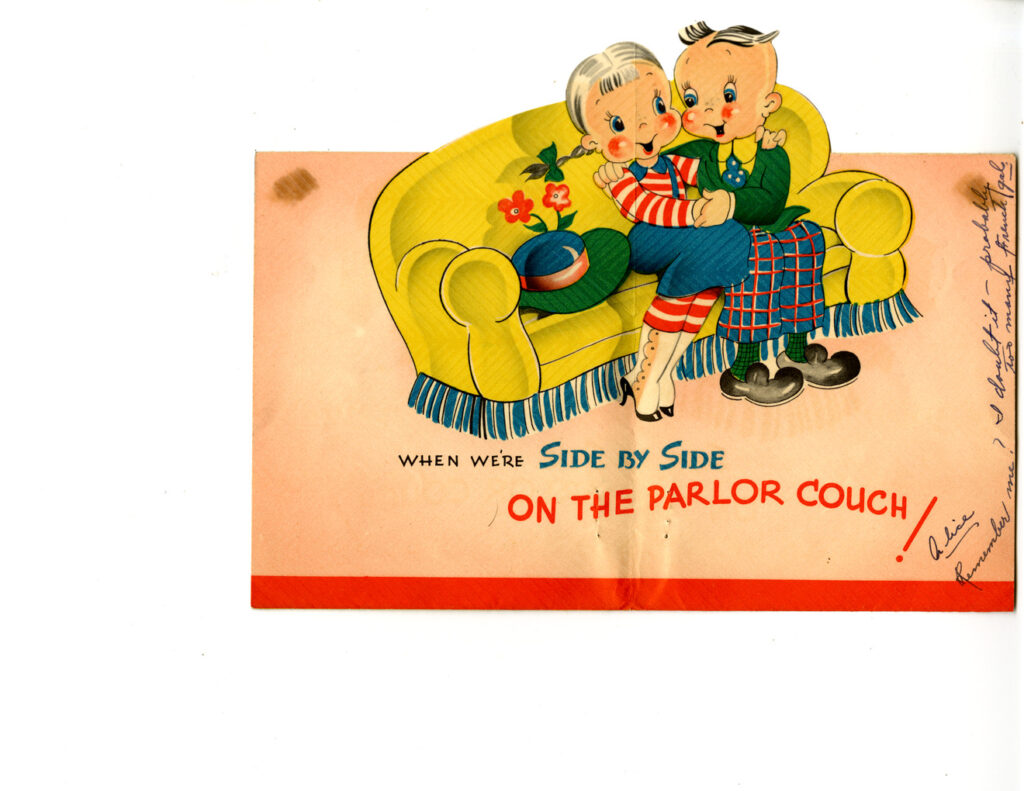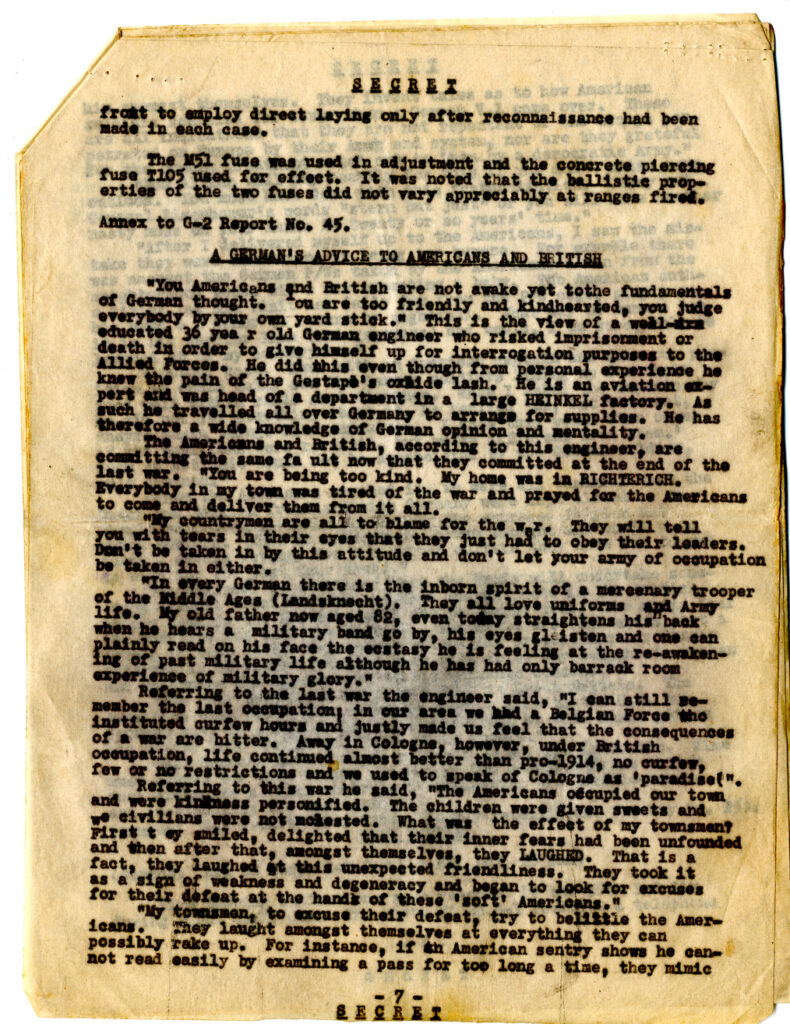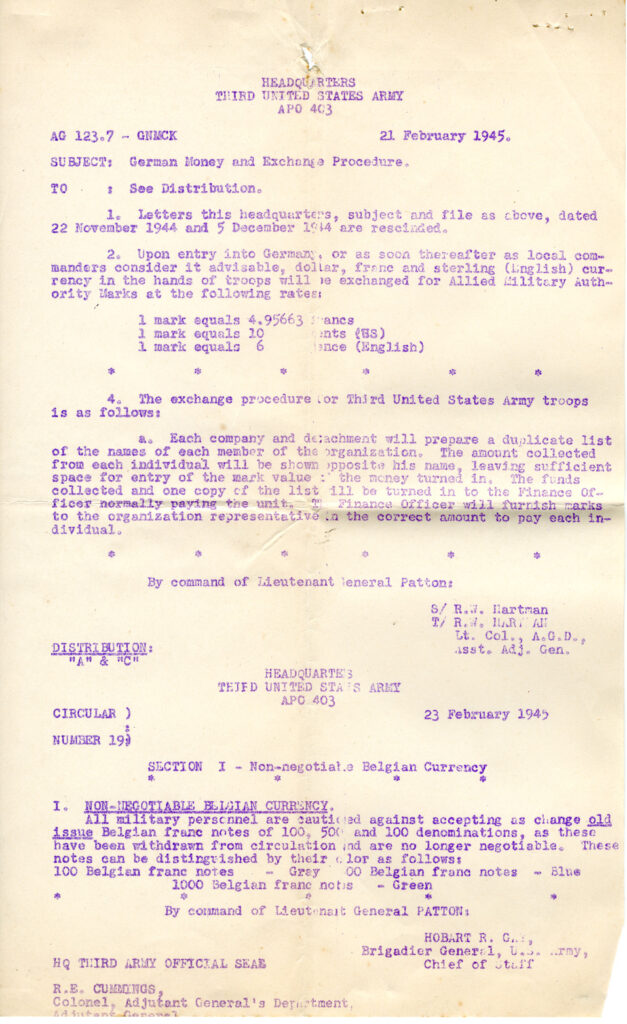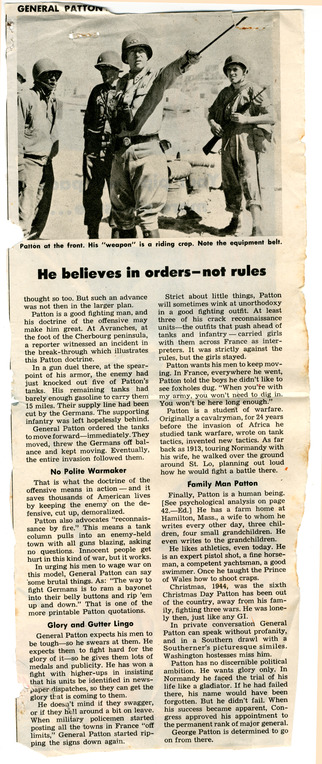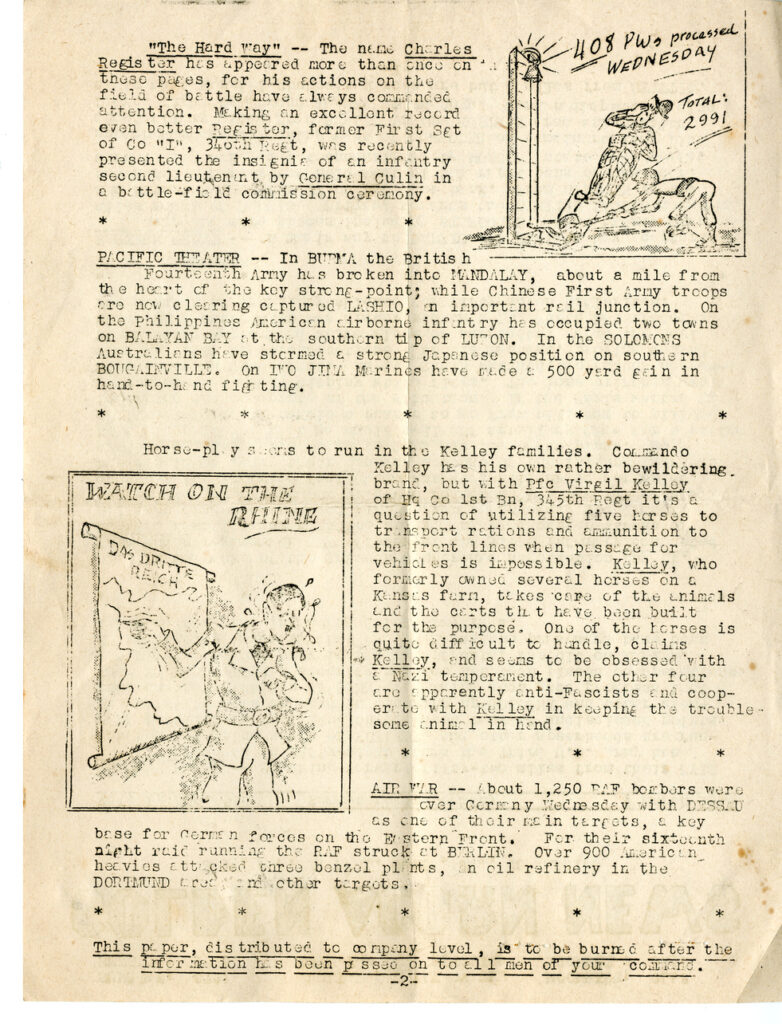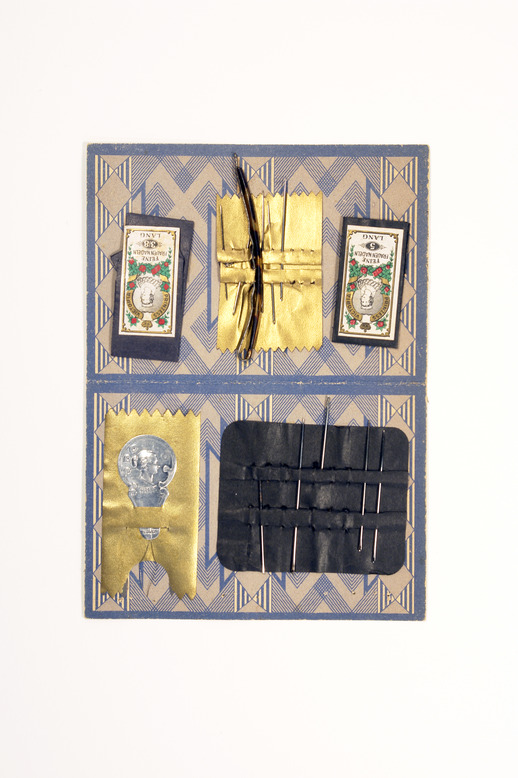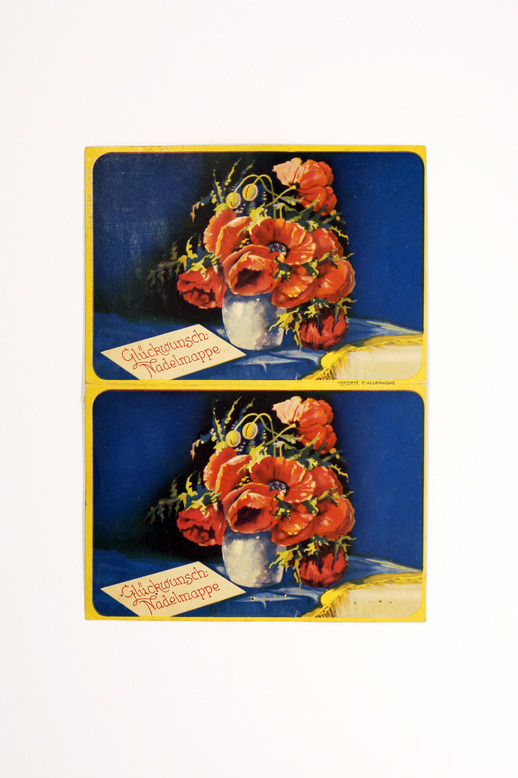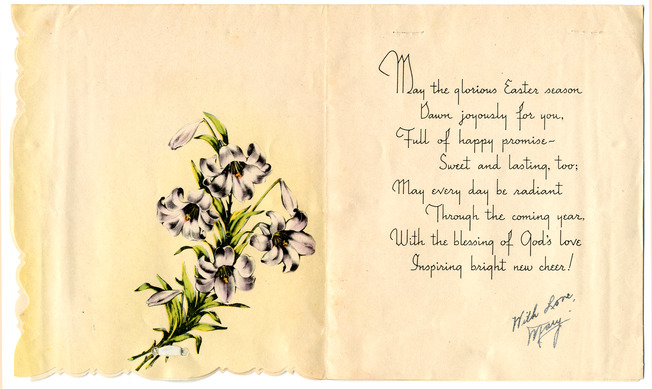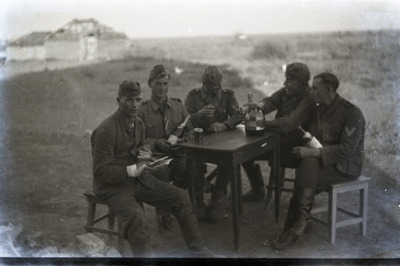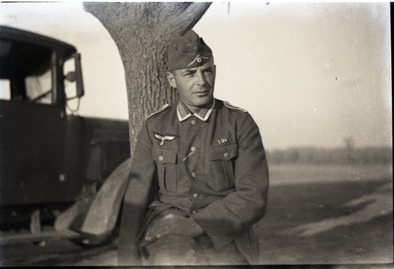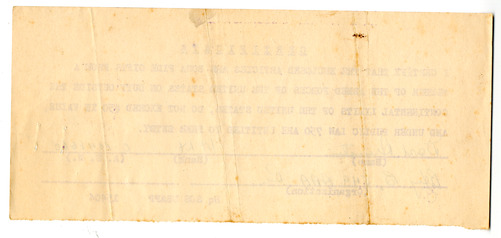
Insert 1a – Introduction
“Lest We Forget,” series published in The Reader’s Digest, n.d.; “Nazi Murder Factory,” by W.H. Lawrence, condensed from The New York Times, 30 August 1944. – Page 1.
This article was the first installment in a Reader’s Digest series on Nazi atrocities during World War II titled “Lest We Forget.” It was written by New York Times reporter William H. Lawrence and is a condensed version of an article published in the Times on August 30, 1944. This article discussed the journalist’s personal observations when he visited a Nazi concentration camp in Maidanek, Poland.
The author explained that even though he had past experience observing war crime investigations conducted by the Soviet-Polish Atrocities Investigations Commission, he had never witnessed anything so horrific. Lawrence attempted to describe the gas chambers, torture rooms, ovens and mass graves that he saw during his time at the camp. With the American audience in mind, Lawrence attempted to expose the true horror of the Nazi regime in great detail so that Americans were aware of the Nazi atrocities that were committed.
This article was the first insert in Goetz’s diary, and it was stapled to the back of the diary’s title page where he wrote, “This Diary has for obvious reasons neglected to record many of the more gruesome experiences which go hand in hand with war and as a result must be supplemented by the memories of a none too retentive mind.” While Goetz does not mention the Holocaust in his diary, or go into any detail about any other horrific events that he may have seen, the attachment of this article and the other two articles in this series (see Inserts 31 and 33a) represents his effort to bear witness to the atrocities committed by the Nazis. He acknowledged the personal importance of these articles by modifying the title of the series “Lest We Forget.” He crossed out the “We” on the article and changed it to “Lest I Forget,” which was also the title of his diary. By placing this article on the first page, Goetz transformed his diary from a daily journal to an archive of memory.

Insert 1b – Introduction
“Lest We Forget,” series published in The Reader’s Digest, n.d.; “Nazi Murder Factory,” by W.H. Lawrence, condensed from The New York Times, 30 August 1944. – Page 2

Insert 2a (4)– Title Page attachments
Cover inscription from the Plantation Room, Hotel Dixie, Inscriptions on the photograph frame read: “Good luck Vernon (our ‘Henry Fonda’). If you are as nice as Bob, you must be ‘tops’ too! Kaye.” “Was it your words that make me dream? Safe journey and come back Vernon. Diane”

Insert 2b (1)— Title Page attachment
Reichs Mark note (1) from the Buchenwald concentration camp. Buchenwald was liberated by the Third Army, to which Goetz’s unit was attached. Goetz hid these notes behind the German banknote.

Insert 2b (2)— Title Page attachment
Reichsmark notes from the Buchenwald concentration camp, located on the Ettersberg near Weimar, Germany. Buchenwald was liberated by the Third Army, to which Goetz’s unit was attached. In an oral history interview, Mary Cobuzzi, daughter of Captain John Van Mameren, the commander of Goetz’s company, explained that her father had told her that his unit had been involved in the liberation of Buchenwald, and that they forced the Germans who lived in the vicinity of the camp to march through it despite their claims that they did not know what was going on inside. Van Mameren made clear to his daughter that he did not accept the veracity of these claims since the smell of burnt bodies permeated the air for miles around the camp. Interview with Mary Cobuzzi, April 2016.
Goetz hid these notes behind the 1000 Marks Reichsbanknote, above.
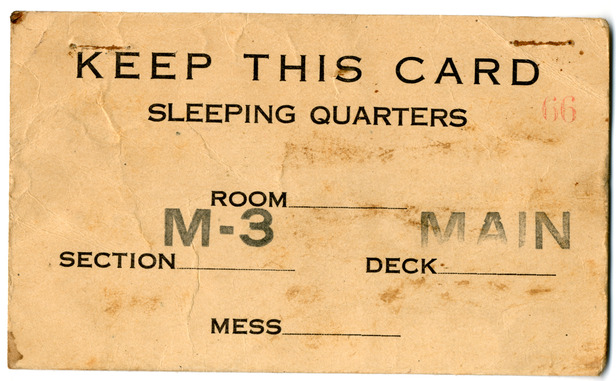
Insert 3— Thursday, September 28, 1944
Printed card with Goetz sleeping assignment on the Highland Monarch.

Insert 4a— Saturday, September 30, 1944
Printed calendar, October 1944‐March 1945, reflecting Goetz’s time in Europe, with prayers on the back.

Insert 5— Monday, October 16 1944 (front)
Calling card of Mrs. Stanley G. Clemow (Phyllis Margery Clemow). Mrs. Clemow was the widow of
Stanley G. Clemow(1899‐1941), a Hungerford chemist who had a shop at 125 High Street.
“125 High Street,” Hungerford Virtual Museum.

Insert 5— Monday, October 16 1944 (back)
Calling card of Mrs. Stanley G. Clemow (Phyllis Margery Clemow), reverse.

Insert 6— Thursday, October 19, 1944
Small photograph of an unidentified woman, perhaps Mrs. Clemow. (See Insert 5)
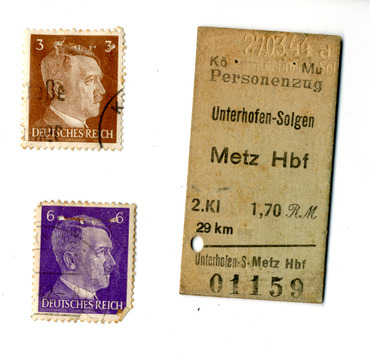
Insert 7— Thursday, December 7, 1944
Images on left–Two German postage stamps featuring image of Adolph Hitler and the words Deutches Reich, or German empire . The purple stamp cost 6 pfennig or pennies, and the brown stamp cost 3 pfennig.
Image on right– A second class train ticket from Unterhofen-Solgen to Metz. Unterhofen-Solgen was the German name given to the neighboring French towns of Secourt and Solgne, located in the Lorraine region of northeastern France, approximately 17 miles (29 km) southeast of Metz.
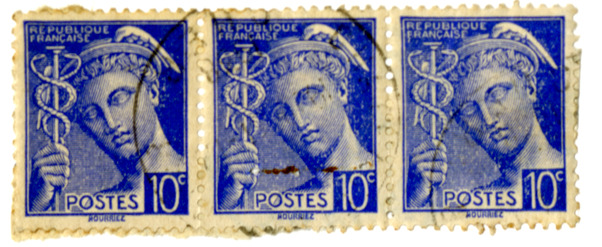
Insert 8b— Friday December 8, 1944
French stamps. The three stamps with the image of Mercury are 10 centime stamps. Above Mercury’s head , the small print reads “Republique Francaise,” suggesting that these stamps were issued before the German occupation and the establishment of the Vichy government, most likely between 1938 and 1940.
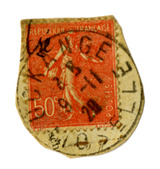
Insert 8a— Friday December 8, 1944
This postmarked stamp is a 50 centime stamp. The postmark came from Uckange, Moselle region of France, dated 1929.
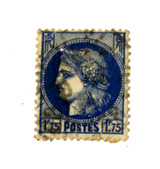
Insert 8c— Friday December 8, 1944
This 1.75 franc stamp with the image of the Roman goddess, Ceres (bottom right) dates from around 1940.
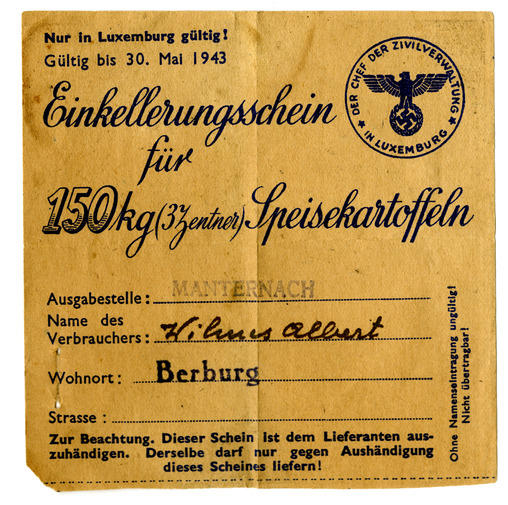
Insert 9a–Wednesday, December 13, 1944
This is an Einkellerungsschein, a certificate issued to Albert Wilmes in order to receive 330 pounds of potatoes, valid only in Luxembourg until 30th of March 1943. Potatoes were delivered to cities by trucks in huge amounts and kept in cellars – Keller in German – and issued out to people by use of official certificates such as this. The certificate reads:
“Issuing Office: Manternach Name of Customer: Albert Wilmes
City: Berburg Street:
Attention. This card is to be handed over to the supplier. They may only deliver after they receive the card. Invalid without signature. May not be reused.”
Throughout the Nazi occupation of Luxembourg, most food grown and processed in the country was appropriated by the German Army, and the people of Luxembourg were forced to endure the Nazi administration of a system of food rationing. Luxembourgians struggled to survive with the meager food allowance they were given. Potatoes became the main staple of their wartime diet.
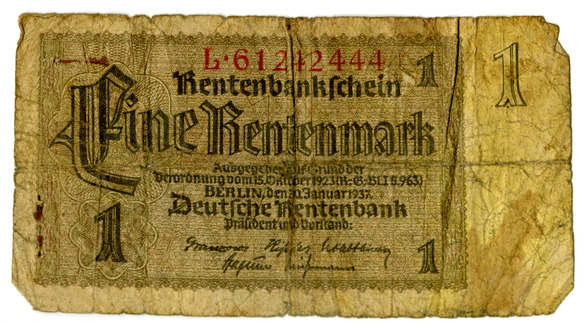
Insert 9b(1)—Wednesday, December 13, 1944
A German Rentenmark, or temporary legal tender issued in 1923 and used up until 1948 to ease
hyperinflation. This one Rentenmark bill was issued in January 1937.
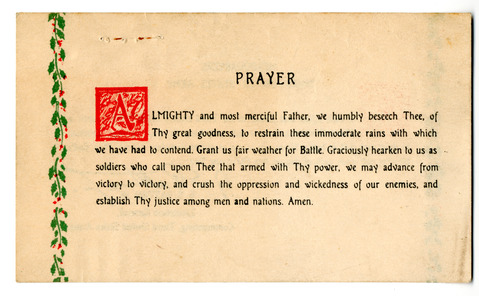
Insert 11a— Monday, December 18, 1944
This is the famous Patton prayer card issued to all members of the Third Army, to which Goetz’s unit was attached, beginning on December 12, 1944. The prayer and Christmas greeting were composed by the chaplain of the Third Army, James H. O’Neill, at the request of General George Patton, who believed that prayer could provide his troops with relief from the long period of rainy weather that had slowed the army’s movement throughout the fall of 1944. Patton ordered O’Neill to print 250,000 copies of the prayer card. He also ordered him to send out a training letter to all the chaplains in the Third Army instructing them to preach the importance of prayer to their troops.
On December 23rd, the rain stopped and the cloud cover broke, allowing for the parachute airdrop of much needed supplies to the besieged troops of the 101st Airborne division in Bastogne, and for the resumption of air attacks on German troops. Three days later, the advance units of Patton’s army arrived in Bastogne, marking a pivotal moment in the Battle of the Bulge. According to James O’Neill’s recollection of events, Patton later remarked: “Well Padre, our prayers worked. I knew they would.” James H. O’Neill, “The True Story of the Patton Prayer,” Review of the News, 6 October 1971, www.pattonhqu.com/prayer.
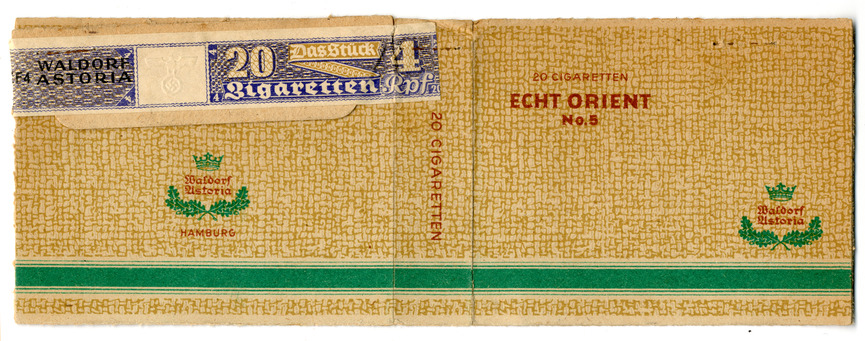
Insert 12a— Thursday, December 21, 1944
Cardboard fragment (2.5” x 7”in.) of a 20‐cigarette carton produced by the German tobacco company, Waldorf‐Astoria, in Hamburg, Germany. The Waldorf Astoria company was established on January 1, 1906. In 1929, it was acquired by Reemtsma, another German cigarette manufacturer. Cartons of Echt Orient No. 5 were distributed by the Wehrmacht to German troops during the war.

Insert 13b— Sunday, December 24, 1944
2 Franc note, (2.5” x 3”), “Emis en France,” “Série de 1944.” Slogan on the back reads: “Liberté/ Egalité/Fraternité.”
This 2 Franc note was issued in 1944 as Allied Military Currency for France following the Allied invasion of France in June 1944. This note was printed in Boston by the Forbes Lithograph Manufacturing Company on behalf of the U.S. Bureau of Engraving and Printing. It was issued to troops entering France in order to supplement the local French currency. Allied Military Currency remained in circulation until financial affairs returned to normal and local currency supplies stabilized. This 2 Franc note was known as the “flag ticket” franc due to the tricolor French flag displayed on the reverse side of the banknote.
Historical Resource Center, Bureau of Engraving and Printing, “ BEP History Fact Sheet: Special and Allied Military Currency,” www.monefactory.gov.
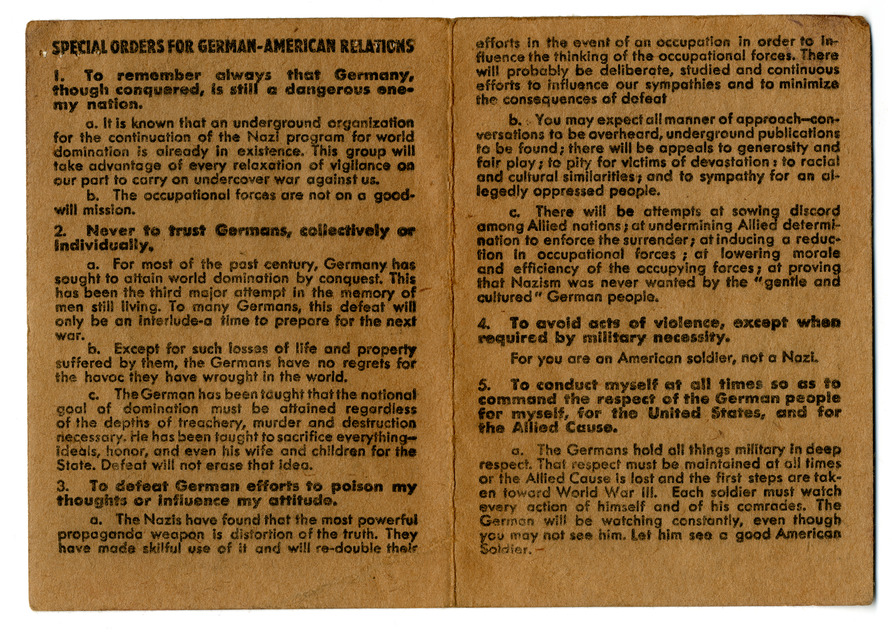
Insert 14a— Thursday, December 28, 1944 (Page 1)
This small pamphlet (5” x 7”), designed to be tucked inside a helmet‐liner or to be inserted into a wallet, instructed U.S. troops about the Army’s non‐fraternization policy. The non‐fraternization policy, which was officially announced after American troops first entered German territory in September, 1944, informed soldiers how they were to conduct themselves with German civilians. “As conquerors,” General Omar Bradley wrote, “we must now consider our relations with the people of Germany.” Bradley commanded his soldiers to be “fair but firm” with the German people, but never to trust or associate with them. While the American army had defeated German soldiers on the battlefield, it was also important to defeat and discredit them in their homeland: “You personally must prove to the German people that their acceptance of Nazi leadership is responsible for their defeat and that it has earned for them the distrust of the rest of the world.”
Goetz expressed doubts about the wisdom of the non‐fraternization policy several times in his diary. At the end of April, 1945, he wrote: “I have been trying to reconcile myself to this business of NonFraternization but although I approve of it, theoretically, I cannot see it working in practice. A few modifications would improve it materially. What are we to gain by being harsh with children? They have had enough of misery and hardships. By treating them kindly, they will have little trouble making comparisons between us and the super race. We would not be the ones to suffer.” Vernon Goetz Diary, 19‐26 April, 1945. For a good discussion of the non‐fraternization policy, see Ann Elizabeth Pfau, Miss Yourlovin: GIs, Gender, and Domesticity during World War II (New York: Columbia University Press, 2013, c2008), ACLS Humanities E‐Book, Chapter 3.

Insert 14b— Thursday, December 28, 1944 (Page 2)
Headquarters
Twelfth Army Group
Europe
I need not speak of your past accomplishments, other than to say you have reflected great credit upon yourself and your command.
We are now fighting on German soil, and we are in contact not only with the soldiers of our enemy but also civilians of Germany. As conquerors, we must now consider our relations with the people of Germany.
It is imperative that you do not allow yourself to become friendly with Germans, but at the same time you must not persecute them. American soldiers can and have beaten German soldiers on the field of battle. It is equally important that you complete the victory over Nazi ideas.
To guide you I have issued these special ” battle ” orders. They may appear to lead along a narrow path, but they are NECESSARY. You personally must prove to the German people that their acceptance of Nazi leadership is responsible for their defeat, and that it has earned for them the distrust of the rest of the world.
[signed] O N Bradley
LIEUTENANT GENERAL, U.S. ARMY
COMMANDING
SPECIAL ORDERS FOR GERMAN-AMERICAN RELATIONS
1. To remember always that Germany, though conquered, is still a dangerous enemy nation.
a. It is known that an underground organization for the continuation of the Nazi program for world domination is already in existence. This group will take advantage of every relaxation of vigilance on our part to carry on undercover war against us.
b. The occupational forces are not on a good-will mission.
2. Never to trust Germans, collectively or individually.
a. For most of the past century, Germany has sought to attain world domination by conquest. This has been the third major attempt in the memory of men still living. To many Germans this defeat will only be an interlude – a time to prepare for the next war.
b. Except for such losses of life and property suffered by them, the Germans have no regrets for the havoc they have wrought in the world.
c. The German has been taught that the national goal of domination must be attained regardless of the depths of treachery, murder and destruction necessary. He has been taught to sacrifice everything— ideals, honor, and even his wife and children for the State. Defeat will not erase that idea.
3. To defeat German efforts to poison my thoughts or influence my attitude.
a. The Nazis have found that the most powerful propaganda weapon is distortion of the truth. They have made skillful use of it and will re-double their efforts in the event of an occupation in order to influence the thinking of the occupational forces. There will probably be deliberate, studied and continuous efforts to influence our sympathies and to minimize the consequences of defeat.
b. You may expect all manner of approach—conversations to be overheard, underground publications to be found; there will be appeals to generosity and fair play; to pity for victims of devastation: to racial and cultural similarities; and to sympathy for an allegedly oppressed people.
c. There will be attempts at sowing discord among Allied nations; at undermining Allied determination to enforce the surrender; at inducing a reduction in occupational forces; at lowering morale and efficiency of the occupying forces; at proving that Nazism was never wanted by the “gentle and cultured” German people.
4. To avoid acts of violence, except when required by military necessity.
For you are an American soldier, not a Nazi.
5. To conduct myself at all times so as to command the respect of the German people for myself, for the United States, and for the Allied Cause.
a. The Germans hold all things military in deep respect. That respect must be maintained at all times or the Allied Cause is lost and the first steps are taken toward World War III. Each soldier must watch every action of himself and of his comrades. The German will be watching constantly, even though you may not see him. Let him see a good American Soldier.
b. Drunkenness will not be tolerated. Penalties will be severe.
6. Never to associate with Germans.
a. We must bring home to the Germans that their support of Nazi leaders, their tolerance of racial hatreds and persecutions, and their unquestioning acceptance of the wanton aggressions on other nations, have earned for them the contempt and distrust of the civilized world. We must never forget that the German people support the Nazi principles.
b. Contacts with Germans will be made only on official business. Immediate compliance with all official orders and instructions and surrender terms will be demanded of them and will be firmly enforced.
c. American soldiers must not associate with Germans. Specifically, it is not permissible to shake hands with them, to visit their homes, to exchange gifts with them, to engage in games or sports with them, to attend their dances or social events, or to accompany them on the street or elsewhere. Particularly, avoid all discussion or argument with them. Give the Germans no chance to trick you into relaxing your guard.
7. To be fair but firm with Germans.
a. Experience has shown that Germans regard kindness as weakness. Every soldier must prove by his actions that the Americans are strong. This will be accomplished if every soldier treats the Germans with firmness and stern courtesy at all times.
b. Firmness must be tempered with a strict justice. Americans do not resort to Nazi gangster methods in dealing with any people. Remember, your fair but firm treatment of the German people will command the proper respect due a member of a conquering nation.

Insert 15 (front)— Sunday, December 31 1944
20 Franc/Frank note, Belgium, 1940. Front side of note written in French, back side written in Dutch. Image of King Albert I (1875-1934) and Queen Elisabeth (1876-1965) featured on front side.
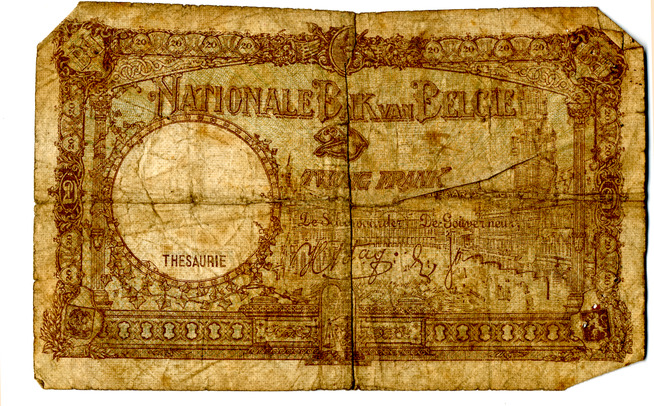
Insert 15 (back)— Sunday, December 31 1944
20 Franc/Frank note, Belgium, 1940. Front side of note written in French, back side written in Dutch. Image of King Albert I (1875-1934) and Queen Elisabeth (1876-1965) featured on front side.
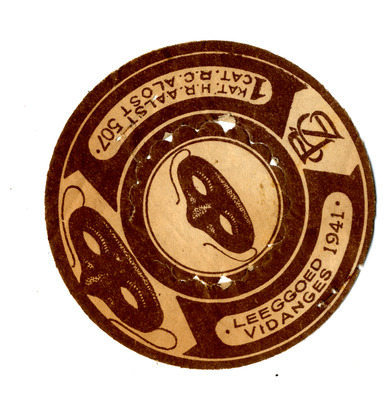
Insert 16— Sunday, December 31, 1944
Perforated paper label from the Belgian brewery, Brouwerij Zeeberg , located in Aalst, East Flanders. The Brouwerij Zeeberg was founded in 1861 and closed in 1975. “Vidanges 1941” refers to a Belgian law passed on 25 November 1941 that required emptied bottles to be returned to the brewery.
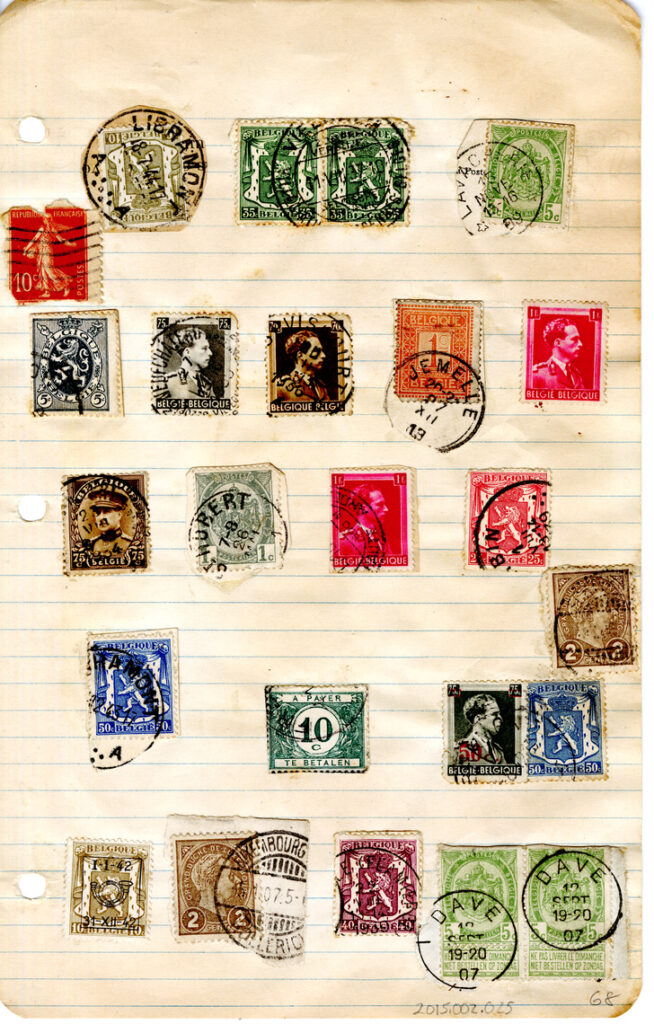
Goetz Diary page_035
Stamps, Postmarks, and Memory: Collection of postmarked stamps, mostly from Belgium, but also including one from France and two from Luxembourg. Several of the postmarks were from cities and towns in or near where Goetz and his unit were stationed in Belgium during and just after the Battle of the Bulge, including Libramont, Neufchateau, Jemelle, St. Hubert, Viscourt, and Dave.
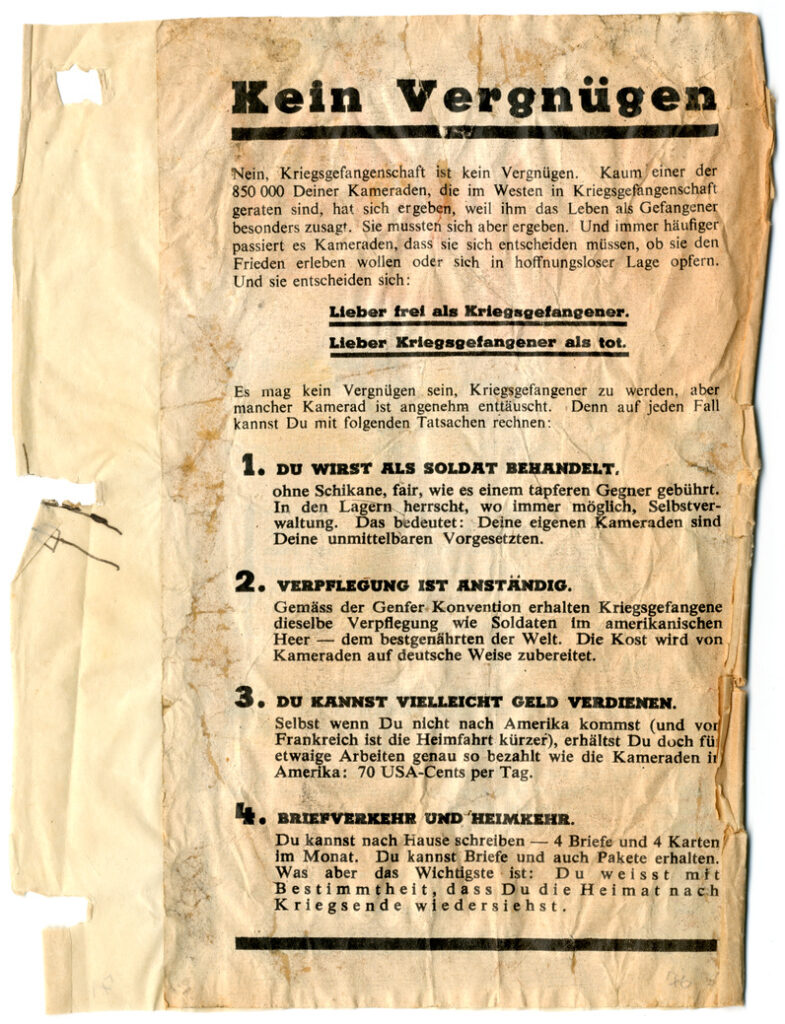
GoetzDiary_2015.002.026a
This is one side of a two-sided leaflet, entitled “No Joke,” intended to persuade German soldiers to surrender. It was produced by the Psychological Warfare Division of the Supreme Headquarters of the Allied Expeditionary Force (PWD/SHAEF), first printed January 5, 1945 and dropped on German troops, January 11-January 24, 1945. ZG 100.
PWD/SHAEF was established in 1943 and united both British and American government agencies to expand propaganda leaflet operations. This agency was responsible for some of the largest leaflet operations during the war, dropping hundreds of millions of leaflets on German soldiers. During the war leaflets like this were often used to disseminate propaganda to German soldiers to try to convince them to surrender or to lower their morale. These leaflets often tried to use reliable information with the sources of the information clearly labeled. This was done in the hopes of convincing German soldiers to trust the information in the leaflets, so that they would have a more significant impact.
For other leaflets produced by PWD/SHAEF and attached to the Goetz diary, see inserts from Sunday, February 4, 1945 and Friday, February 9, 1945.
Leaflet translation:
“NO JOKE”
No, captivity is no pleasure. Hardly any of your 850,000 comrades who have been captured in the West surrendered because the life of a captive appealed to him. They had to surrender, however. And more and more often, comrades, they must decide whether they want to experience peace or sacrifice themselves in a hopeless situation. They decide:
Better free than a prisoner of war.
Better a prisoner of war than dead.
It may not be pleasurable to be a prisoner of war, but many are pleasantly disappointed. In any case, you can expect the following:
1. You will be treated as a soldier,
without harassment, fairly, as is due to a courageous opponent. In the camp, self-government rules wherever possible. This means: Your own comrades are your immediate superiors.
2. Provisions are decent.
According to the Geneva Convention, prisoners of war receive the same provisions as soldiers in the American army – the best fed in the world. The food is prepared by comrades in the German way.
3. You can perhaps earn money.
Even if you don’t go to America (and the trip home from France is shorter), you receive the same payment for possible work as your comrades in America: 70 USA-cents per day.
4. Correspondence and homecoming.
You can write home – 4 letters and 4 cards in a month. You can also receive letters and parcels. What is most important, however: You know with certainty that you will see your home again after the war ends.”
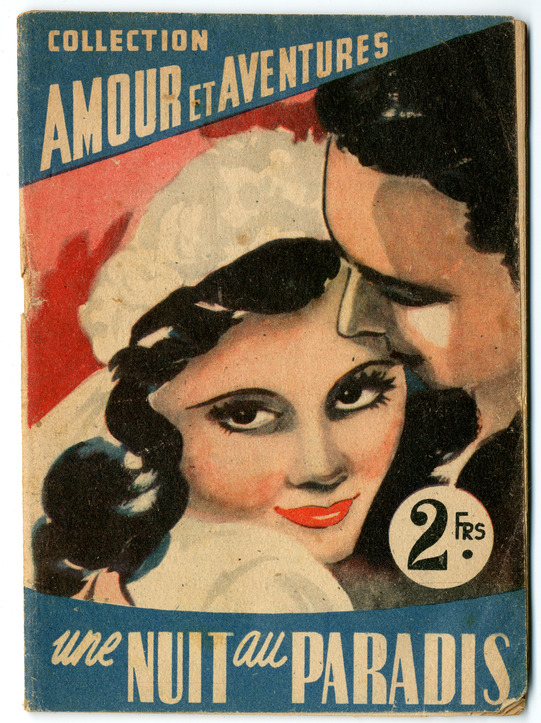
GoetzDiary_2015.002.027a
“Love and Adventures, One Night in Paradise”: front cover of 32-page paperback serial romance published in Brussels by “S.P.R.L. EDITO, 15 bd Barthelemy, Bruxelles.”
This is a 32-page stand-alone short story published as part of an ongoing series Amour et Aventures (Love and Adventures). S.P.R.L Edito published the series in Brussels, Belgium. The story of this issue is Une Nuit au Paradis (A Night in Paradise) written by Pierre Deumarteau. In the story, an unnamed traveler in Navarre, Spain encounters a young girl, Bianca, who is looking for a ride. The traveler agrees to help Bianca, but when their car breaks down they are forced to stay in the same town from where she is trying to escape. Bianca tells the traveler the story of her life and her forbidden romance with the young architect, Antonio. The rest of the story follows the traveler in his attempt to save Bianca from her controlling aunt as well as from an arranged marriage and to reunite Bianca with Antonio. The first and last pages of the books contain an excerpt from the story Buenos-Ayres: Derniere Escale (Buenos Aires: Last Stop) written by Maurice Ruffine. The book advertises this story as being continued in the next issue of the series.

Insert 19a— Friday, January 5, 1945
Newspaper clipping entitled “Yanks in Belgium Experience Winter Warfare at its Worst,” by Laurence Mascott, Stars and Stripes, 19 January 1945.
“With 83rd INF DIV, Jan. 19. This is Belgium and this is Valley Forge, and this is cruel, savage winter warfare at its worst. For four days and four nights, infantrymen of this division have attacked incessantly and made good progress in the face of bitter, last‐ditch Nazi resistance. The temperature is almost always below freezing and except for last night, all night attacks have been made in snow storms and biting winds. Drifts have accumulated to over 36 inches in depth and blankets of snow cover the icy roads. Here are some examples of probably the most miserable fighting conditions under which Americans have been engaged since the trials of Valley Forge and Trenton. Morphine syrettes freeze. It was impossible to administer the crucial drug on the battlefield until the medics hit on the scheme of keeping the syrettes warm under their armpits. Plasma also freezes and must be kept under the hoods of medical jeeps. Automatic weapons freeze over and it is only after they are worked manually a few times that they will function automatically. But they continue to fight on day and night, almost without sleep, subsisting on K rations, unshaven, unwashed, sweating out mortars and artillery, walking over snow‐covered mine‐fields, hoping that the mines will not detonate.”
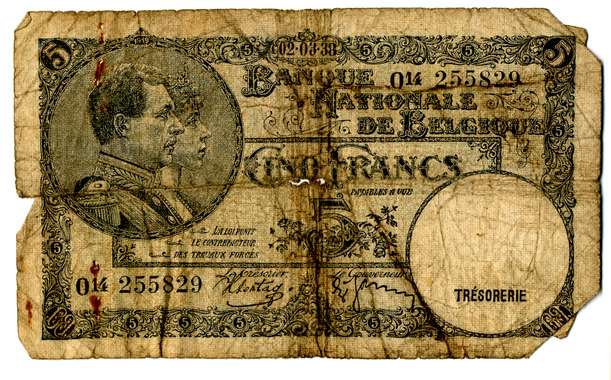
Insert 19b–-Friday, January 5, 1945 (front)
5 franc Belgian banknote, issued 1938, featuring French text with a profile of King Albert I and Queen Elisabeth, who ruled from 1909 until 1934, on the front, and Dutch text with a drawing of a miner, a bin of coal, and miners’ tools, on the back.
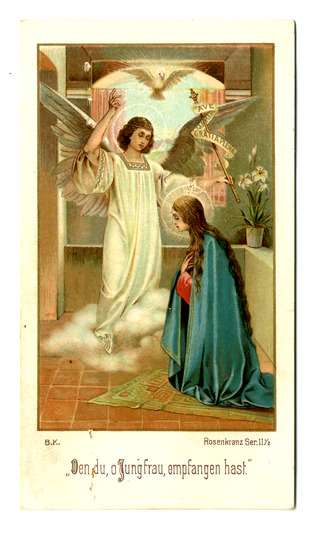
Insert 21a(1)–Friday, January 12, 1945
Virgin Mary Prayer Card. The front of the card depicts the Annunciation, wherein the Angel Gabriel announced to the Virgin Mary that she would conceive and bear a son who was to be called Jesus. The German text below the image reads: “You, oh virgin, have conceived.”

Insert 21a(1)–Friday, January 12, 1945
Virgin Mary Prayer Card. The back of the card contains German text describing the first Joyful Mystery of the Rosary (The Annunciation) and a prayer to be used during the recitation of the Rosary, asking Mary to intercede on the reader’s behalf so that the reader may join Jesus in the Holy Communion. This card was printed in Köln, Germany by B.K. (possibly the publishing house of B. Kühlen) as part of their Rosenkranz (Rosary) Series.

Insert 21a(2)–Friday, January 12, 1945
Obituary card for Anna Gondringer (1841‐1902) .The printed image of Mary surrounded by roses features a German text below: “Mary has obtained salvation for us.” The front of the card with the image of Mary was printed by L. Turgis & Fils, Paris. The text of the obituary was printed in Esslen, Gravenmacher.
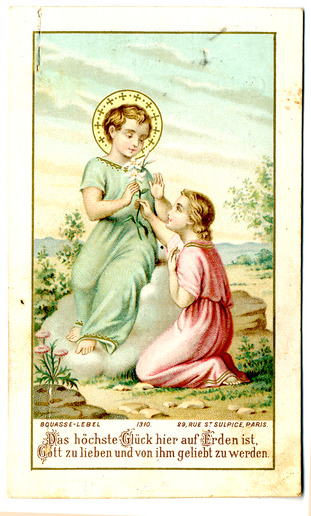
Insert 21b(1)—Friday, January 12, 1945
Holy card depicting the Christ child and another unidentified child exchanging a lily in the desert. The gift of the lily represents the gift of purity and divine love. The German text on the front reads: “The utmost joy here on earth is to love and be loved by God.” The card was printed by the French firm of Bouasse-Lebel, one of a number of holy card printers located on Rue St. Sulpice, Paris.

Insert 21b(1)—Friday, January 12, 1945
The German text on the back commemorates the ordination of Johannes A. Schritz, the first mass he celebrated in Padua, Ohio, at St. Anthony’s Church in June, 1908, and the first mass he celebrated in Gostingen, Luxembourg in August, 1913.
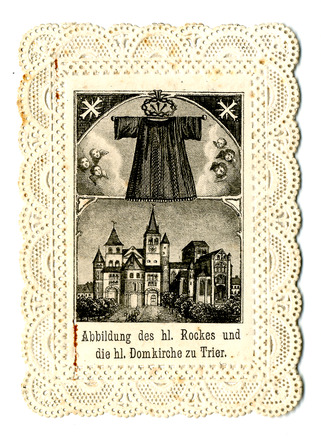
Insert 21b(2)—Friday, January 12, 1945
Holy robe card with lace-like border commemorating the 1891 pilgrimage to the Cathedral in Trier. The German caption under the images reads: “Picture of the holy tunic and the holy cathedral of Trier.”
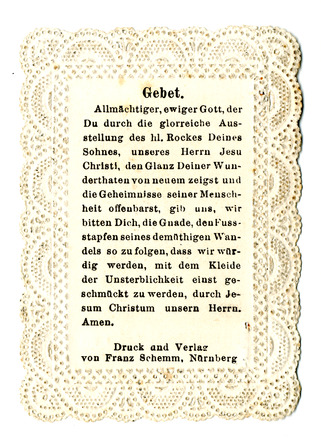
Insert 21b(2)—Friday, January 12, 1945
The prayer on the back of the card asks God for the grace and humility to follow the path of Jesus, “so that we would be worthy of being adorned with the clothes of immortality through Christ our Lord.” The printer and publisher was Franz Schemm, Nuremberg.
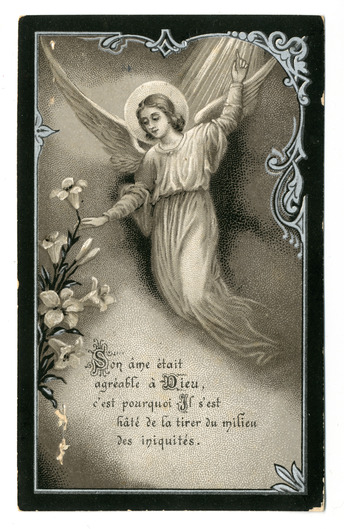
Insert 22a(1) –Monday, January 15, 1945
Obituary card for Maria Engel who died on July 4, 1914. The front of the card, printed in French, reads: “For his soul pleased the Lord: therefore hasted he to take him away from among the wicked.” (Song of Solomon, 4:14) On the back of the card, a message is written in German as if composed by the deceased, urging family members to remain sinless and devout. This card was printed at the Maison Gretsche, by the Bertouy family in Remich, Grevenmacher, Luxembourg.

Insert 22a(2)— Monday, January 15, 1945
Obituary card for Georg Gonderinger who died on April 1, 1911. The front of the card was printed by A&M.B. and depicts the apparition of Jesus to Saint Margaret Mary Alacoque, the saint associated with the devotion to the Sacred Heart. The German text on the front of the card reads: “See here this heart, which has loved the people so much.” The printer of the obituary text was Jacques Gerard, Ettelbruck, Luxembourg.
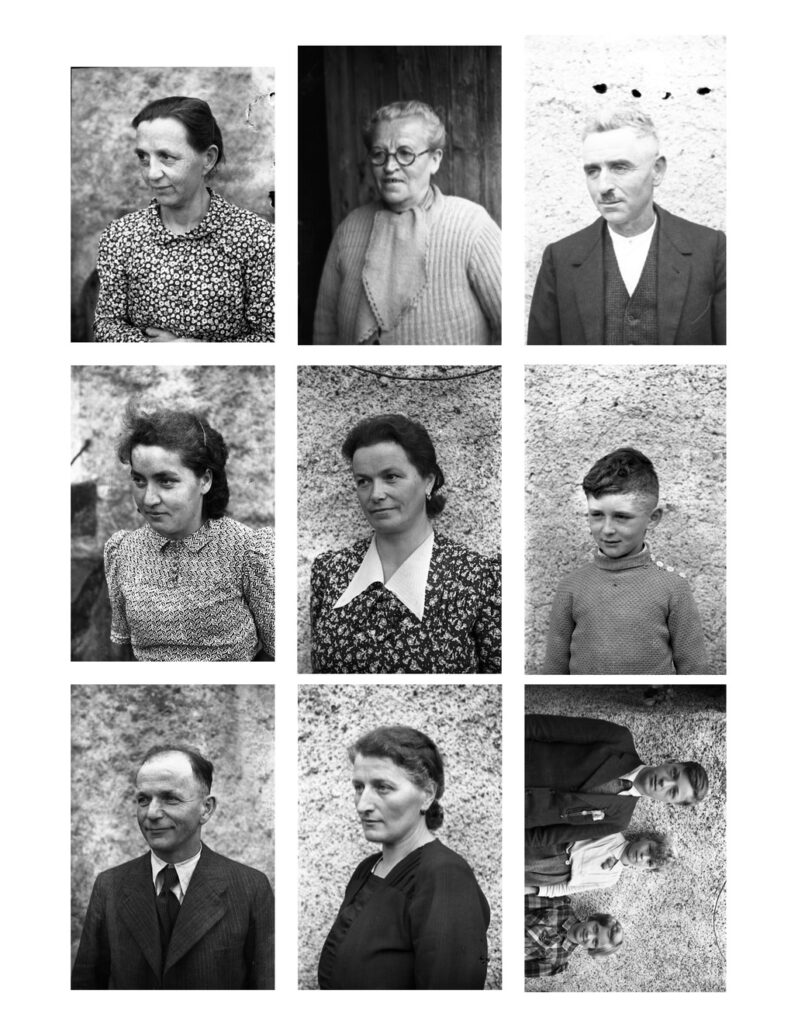
GoetzDiary_2015.002.039r
Preserving the Remnants of European Life
These portraits of Luxembourgians were captured from negatives that Goetz inserted into his diary with the note: “These pictures are of the people whose house we occupied in Beyren. They weren’t at home.”
Current residents of the Luxembourg village of Beyren* have identified the subjects of these photographs as follows:
Row 1 (left to right): Mrs. Catherine Gondringer, unidentified woman, Mr. Nicholas Gondringer
Row 2 (left to right): Mrs. Suzanne Gondringer-Schummer, Mrs. Mathilde Kinn-Seyler, Marcel Gondringer
Row 3 (left to right): Mr. Antoine Gondringer, Mrs. Catherine Kinn, unidentified woman
Four of these people lived in Beyren while the others lived in the neighboring village of Gostingen.
*Information supplied by Mr. Marc Bisdorff, Mayor Theo Weirich, Fernand Rock, family members, and other residents of present day Beyren, Luxembourg.
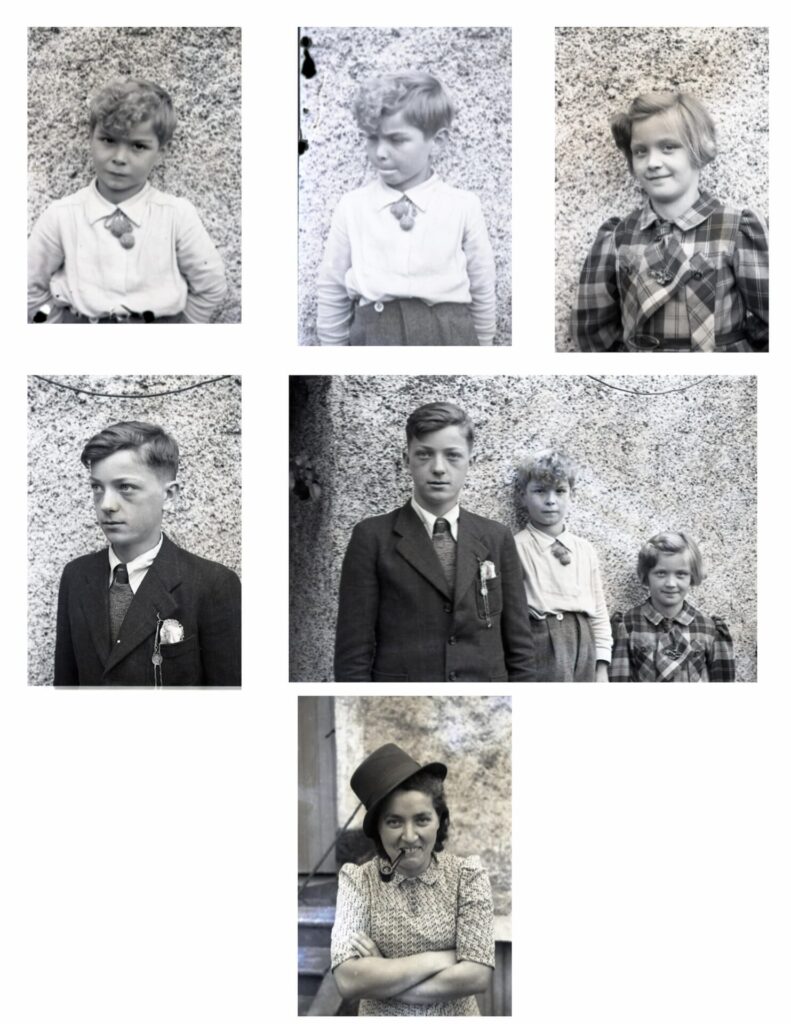
GoetzDiary_2015.002.039q
Row 1 (left to right): Norbert Kinn, Maria (no last name supplied)
Row 2 (left to right): Fernand Kinn, Norbert Kinn, Maria
Row 3: Mrs. Suzanne Gondringer-Schummer.
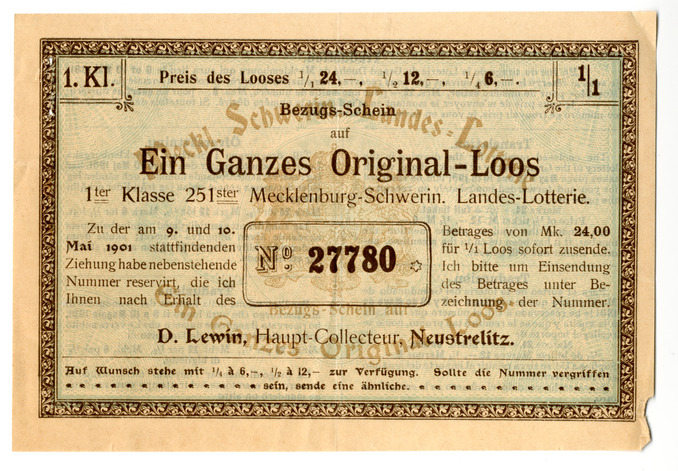
GoetzDiary_2015.002.040a
“A Whole Original Loos,” Sweepstakes ticket for a lottery in the Grand Duchy of Mecklenburg-Schwerin, Germany, scheduled to take place 9 and 10 May, 1901.
Goetz wrote a note on the back of the page in the diary, next to the attached ticket: “Sweepstake Ticket. Picked up at Beyren, Luxembourg, 17 Jan.”

GoetzDiary_2015.002.041a
10 Franc bill, Luxembourg, featuring the image of Charlotte, who reigned as Grand Duchess of Luxembourg (1919-1964), with French text on the front; the Luxembourg coat of arms and the Luxembourgish language is featured on the back. This 10 Franc bill was printed by the American Bank Note Company as part of a large order of currency, requested by the Grand Duchy of Luxembourg in 1944 for the purpose of supplementing local currency during the Liberation period.

GoetzDiary_2015.002.042a
Paper fragment from the Hôtel de Luxembourg, Rue Breydel, 35, Anvers. J.Robert-Thill, Proprietaire.
The Luxembourg Hotel, located on Rue Breydel in Antwerp, Belgium, provided lodging for emigrants from Luxembourg headed to the United States on the Red Star Line of steamships. The Red Star Line provided shipping services for passengers and freight between Antwerp and New York and Philadelphia beginning in 1873 and ending in 1934. The five-story Hotel, operated in 1883 by Mathieu Thill, and after 1894, by J. Robert-Thill, was an important way-station on the long trip from Luxembourg to the United States, offering not only food and shelter for Luxembourgians, but also transportation from the train station and to the Antwerp harbor.
Grace Bello, “Museum in Antwerp Recalls the Ships that Brought Einstein and Irving Berlin to America,” Tablet, 27 November 2013. Online edition; Francois Besch, “Mit der ‘Red Star Line’ uber Antwerpen in die USA,” Tageblatt, 12 June 2007, pp.32-33. Online edition.
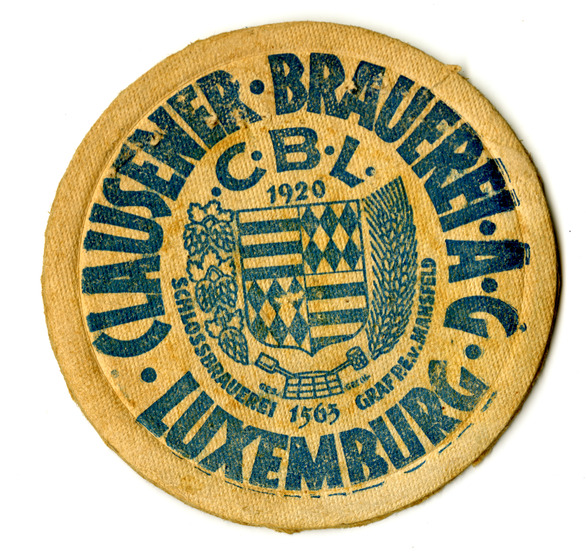
Insert 26a – Wednesday, January 24, 1945
Beer mug coaster, 1920. “Clausener Brauerei A G Luxemburg, Schlossbrauerei 1563 Graf P.E.v. Mansfeld”
The Clausen Brewery of Luxembourg was founded as a castle brewery (schlossbrauerei) in 1563 by Count Peter Ernst von Mansfeld-Vonderort (1517-1604). The coaster features the Mansfeld coat-of-arms surrounded by images of grain, grapes, and brewer’s tools.
The Clausen Brewery merged with the Mousel Brewery in 1971 to become Mousel et Clausen of Luxembourg City. In 2000, Mousel et Clausen merged with Brasserie Diekirch to form Brasserie de Luxembourg Mousel-Diekirch, the second largest brewing company in Luxembourg.
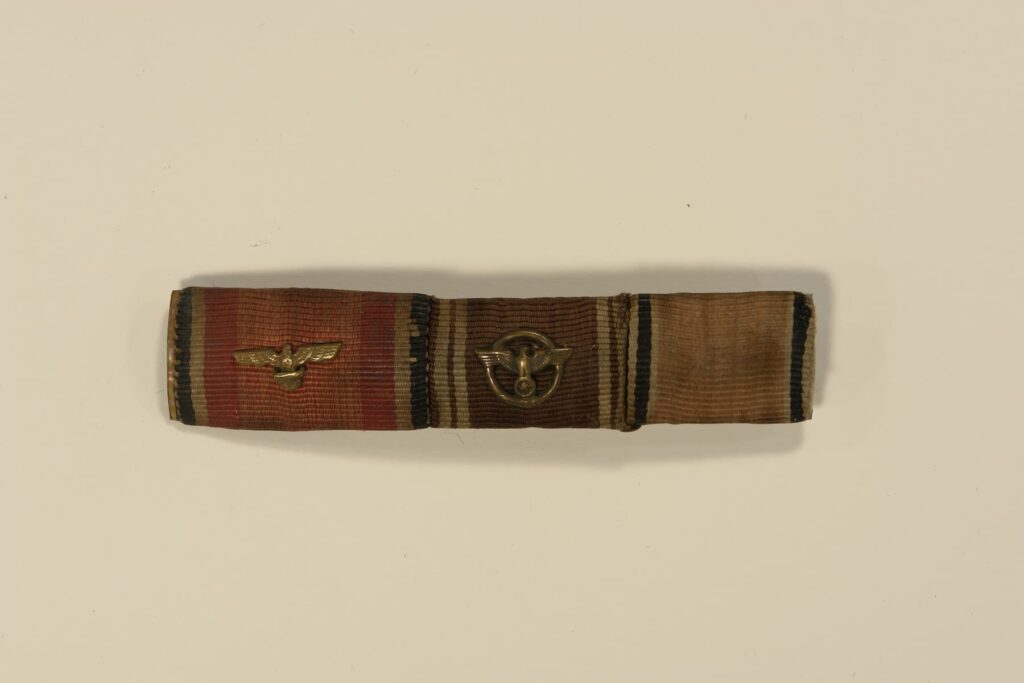
Insert 26b – Wednesday, January 24, 1945
Nazi military ribbon bar featuring: ( from left to right)
— a faded Decoration in Memory of 9 November 1923 ribbon, also known as the Blood Order ribbon commemorating the Munich Putsch, the Nazi party’s attempt to seize power of the German government in Munich 8-9 November 1923. This ribbon was given to party members who served during the Putsch, as well as those who had been imprisoned or wounded in service to the Nazi party prior to 1933.
–the NSDAP (Nazi Party) 10 year service award, which was a political award to honor loyalty to the party.
–the Anschluss Commemorative award, commemorating the annexation of Austria on 13 March 1938.
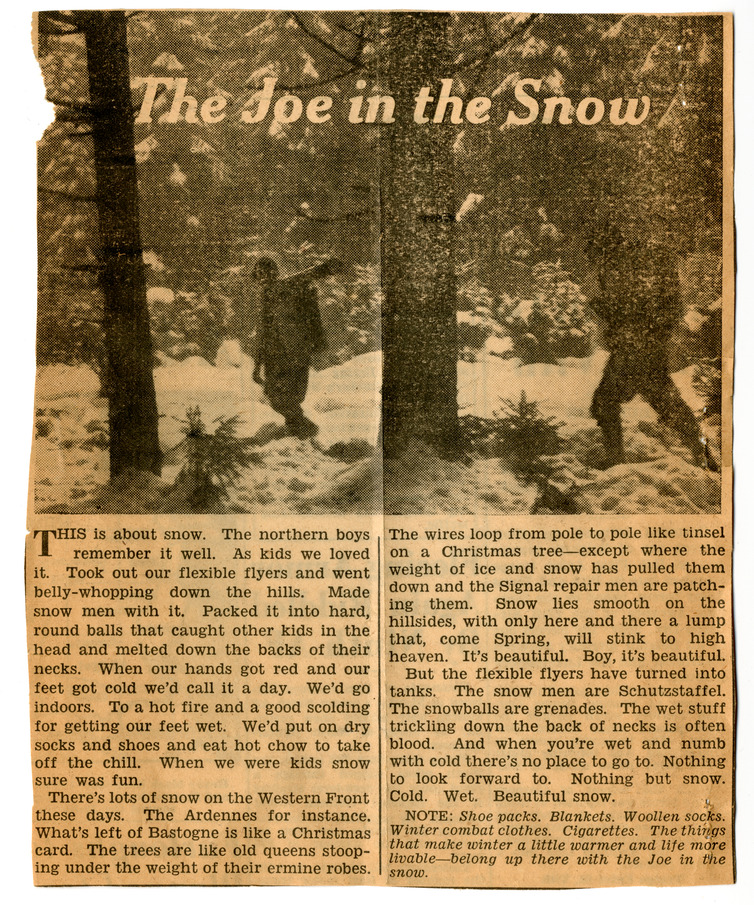
Insert 27— Saturday, January 27, 1945
Clipping of newspaper article titled “The Joe in the Snow,” describing the conditions in Belgium for soldiers during the harsh winter of 1944-1945. Stars and Stripes, Vol. 1, No. 181, n.d.[January 1945]
“This Is about snow. The northern boys remember it well. As kids we loved it. Took out our flexible flyers and went belly-whopping down the hills. Made snow men with it. Packed it into hard, round balls that caught other kids in the head and melted down the backs of their necks. When our hands got red and our feet got cold we’d call it a day. We’d go indoors. To a hot fire and a good scolding for getting our feet wet. We’d put on dry socks and shoes and eat hot chow to take off the chill. When we were kids snow sure was fun.
There’s lots of snow on the Western Front these days. The Ardennes for instance. What’s left of Bastogne is like a Christmas card. The trees are like old queens stooping under the weight of their ermine robes. The wires loop from pole to pole like tinsel on a Christmas tree—except where the weight of ice and snow has pulled them down and the Signal repair men are patching them. Snow lies smooth on the hillsides, with only here and there a lump that, come Spring, will stink to high heaven. It’s beautiful. Boy, it’s beautiful.
But the flexible flyers have turned into tanks. The snow men are Schutzstaffel. The snowballs are grenades. The wet stuff trickling down the back of necks is often blood. And when you’re wet and numb with cold there’s no place to go to. Nothing to look forward to. Nothing but snow. Cold. Wet. Beautiful snow.
NOTE: Shoe packs. Blankets. Woollen socks. Winter combat clothes. Cigarettes. The things that make winter a little warmer and life more livable—belong up there with the Joe in the snow.”
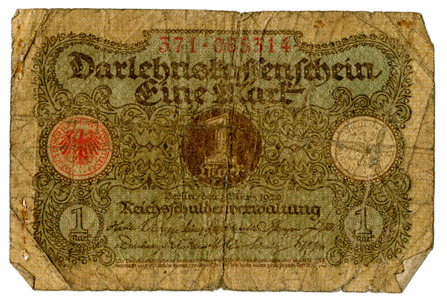
Insert 28b— Tuesday, January 30, 1945 (front)
Darlehnstaffenschein Eine Mark. German emergency currency, issued by the German National Debt Office in Berlin in March, 1920.
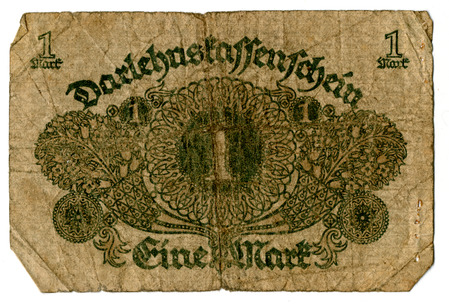
Insert 28b— Tuesday, January 30, 1945 (back)
Darlehnstaffenschein Eine Mark. German emergency currency, issued by the German National Debt Office in Berlin in March, 1920.
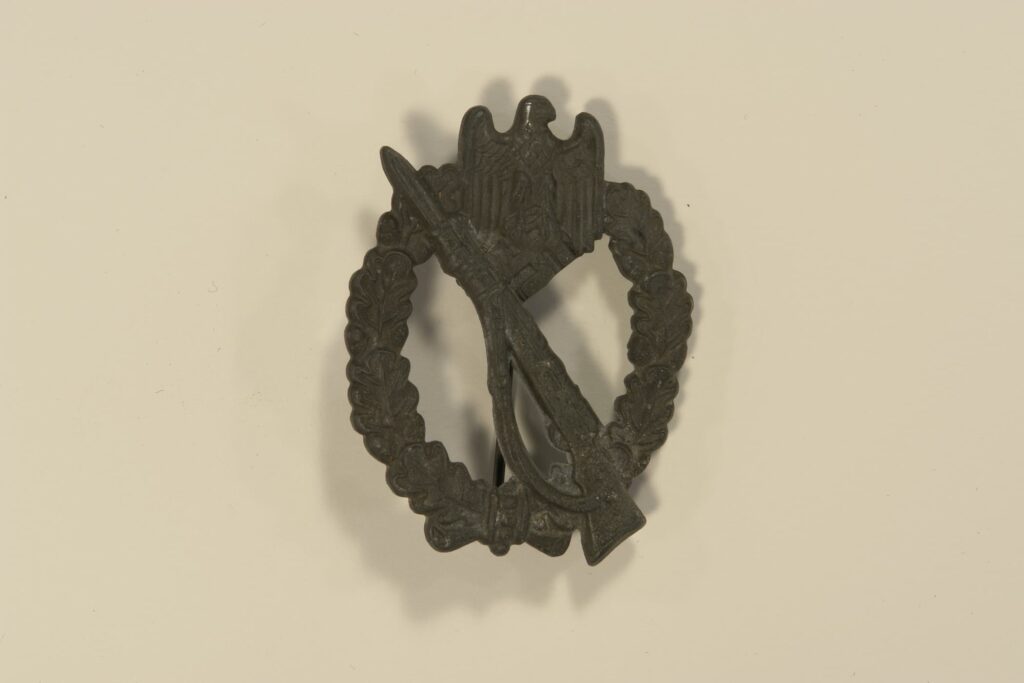
Insert 29— Wednesday, January 31, 1945 top left
Infantry Assault Badge, awarded to motorized Panzer troops for achievements in battle.
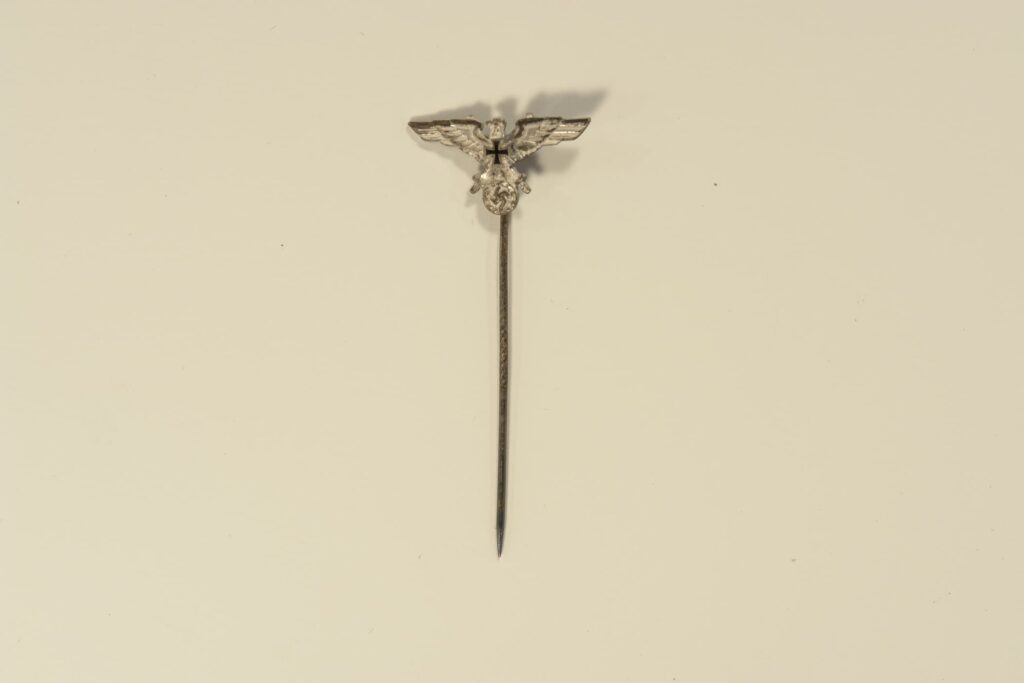
Insert 29— Wednesday, January 31, 1945 bottom right
Army veteran’s pin, given to wounded veterans of World War I by the NSKOV, or National Socialist War Victim’s Care, a social welfare organization established in 1934 and affiliated with the Nazi Party.
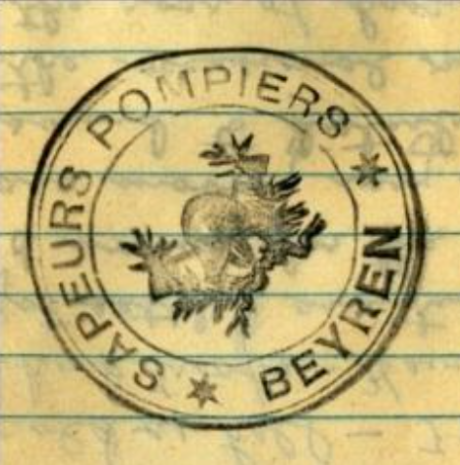
Insert 29
Enhanced stamp of the seal of the Beyren fire department taken from Goetz diary, January 16, 1945. See insert from January 15, 1945.
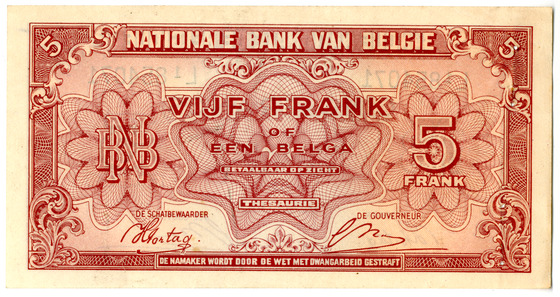
Insert 30a— Thursday February 1, 1945 left
5 Franc Belgian note, 1943, in Dutch. This currency was printed by Bradbury-Wilkinson in England, at the request of the Belgian government-in-exile.
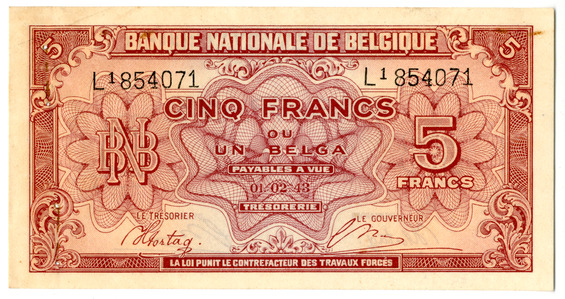
Insert 30a— Thursday February 1, 1945 right
5 Franc Belgian note, 1943, in French. This currency was printed by Bradbury-Wilkinson in England, at the request of the Belgian government-in-exile.
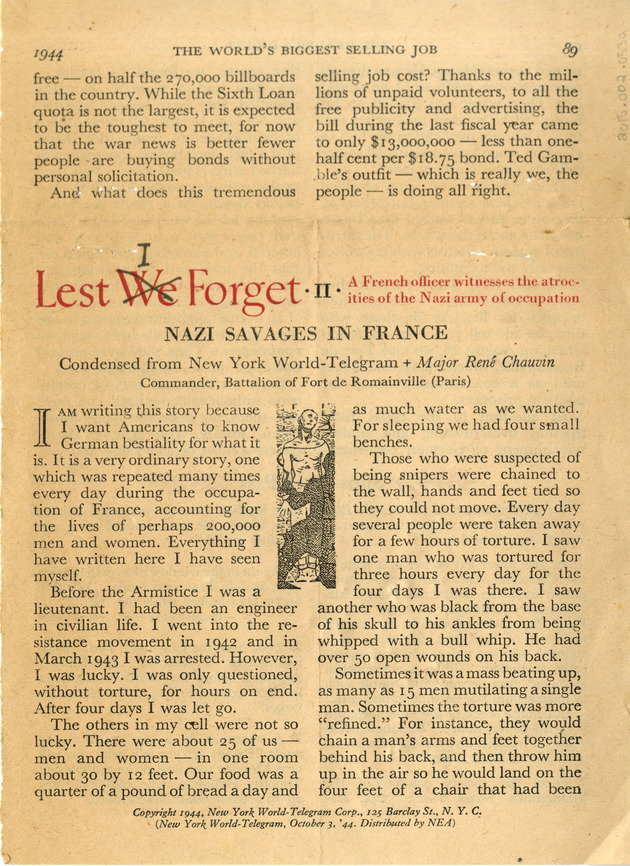
GoetzDiary_2015.002.053a
Rene Chauvin, “Nazi Savages in France,” “Lest We Forget” series, Part II, Reader’s Digest, Vol. 45, No. 272, (December 1944), pp. 89-90.
In this article, a condensed version of an article published in the New York World-Telegram, 3 October 1944, French Army Major Rene Chauvin describes his experiences as a prisoner of war and the torture that he witnessed the Nazis commit. He also describes his observations of Fort de Romainville, a Nazi concentration camp in France, after its liberation. He writes about the state of the dead bodies found in a pile inside the camp as well as a dungeon in which fifty people had been confined and then murdered. He ends his article urging Americans to believe his account of the concentration camps and the Nazis’ horrific atrocities. As he did with the first article in this series, Goetz crossed out the “We” in the title and changed the original title from “Lest We Forget” to “Lest I Forget.” For other articles in the “Lest We Forget” series, see Inserts 1 and 33a.
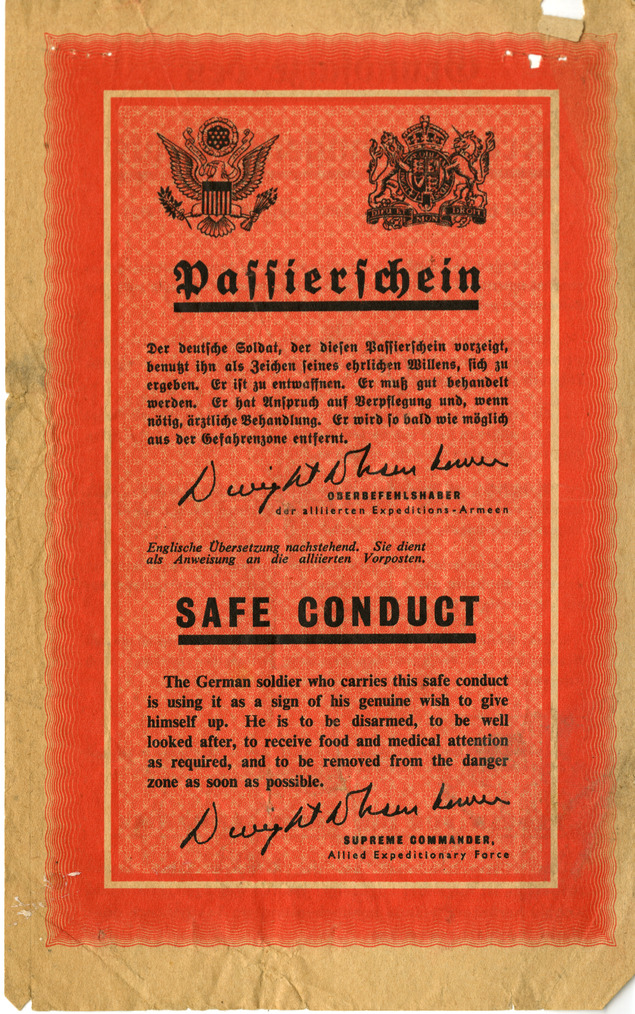
Insert 32— Sunday February 4, 1945 (front)
“Safe Conduct,” Allied leaflet, dropped by Allied aircraft, September 1944- March 1945. Leaflet produced by the Psychological Warfare Division of the Supreme Headquarters of the Allied Expeditionary Force, ZG61-1944.
This “Safe Conduct Pass” was one of the most successful leaflets produced by the Psychological Warfare Division of the Supreme Headquarters of the Allied Expeditionary Force (PWD/SHAEF). It was modeled on previously produced Russian leaflets. This leaflet was dropped on German forces between September 1944 and March 1945. It was intended to encourage German soldiers to surrender. The signature of the Supreme Commander of the Allied Expeditionary Force, General Dwight D. Eisenhower, on the front of the leaflet is a characteristic of “white propaganda,” the most common form of psychological warfare used by the American government, which meant that any propaganda being distributed had to make its origins clear. This leaflet also uses information from the Geneva Convention to inform German soldiers of their rights if they surrender.
“The German soldier who carries this safe conduct is using it as a sign of his genuine wish to give himself up. He is to be disarmed, to be well looked after, to receive food and medical attention as required, and to be removed from the danger zone as soon as possible. Dwight D Eisenhower, Supreme Commander, allied Expeditionary Force.
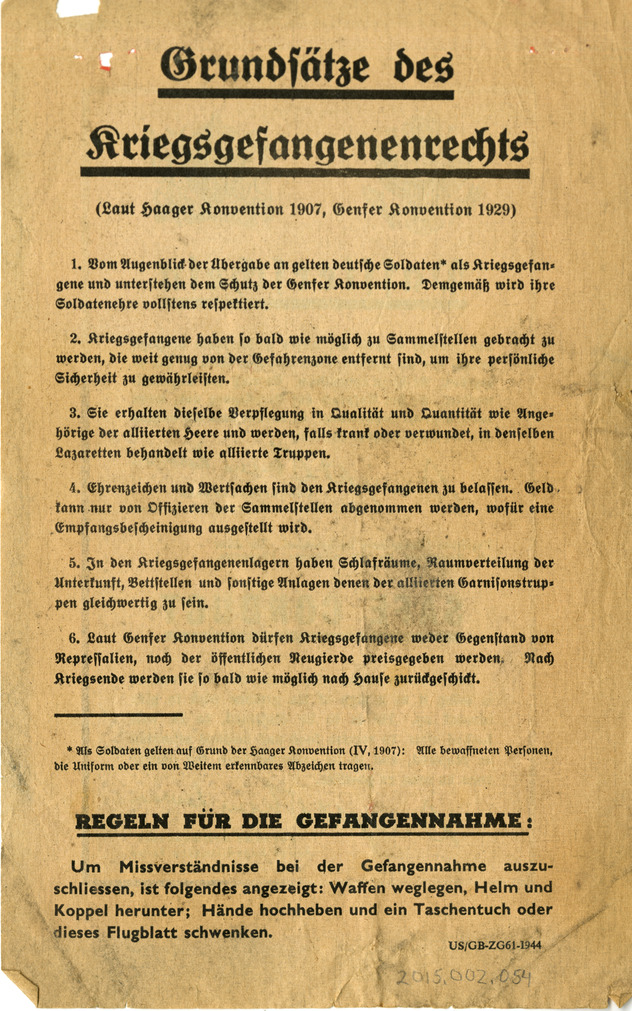
Insert 32— Sunday February 4, 1945 (back)
“Safe Conduct,” Allied leaflet, dropped by Allied aircraft, September 1944- March 1945. Leaflet produced by the Psychological Warfare Division of the Supreme Headquarters of the Allied Expeditionary Force, ZG61-1944.
This “Safe Conduct Pass” was one of the most successful leaflets produced by the Psychological Warfare Division of the Supreme Headquarters of the Allied Expeditionary Force (PWD/SHAEF). It was modeled on previously produced Russian leaflets. This leaflet was dropped on German forces between September 1944 and March 1945. It was intended to encourage German soldiers to surrender. The signature of the Supreme Commander of the Allied Expeditionary Force, General Dwight D. Eisenhower, on the front of the leaflet is a characteristic of “white propaganda,” the most common form of psychological warfare used by the American government, which meant that any propaganda being distributed had to make its origins clear. This leaflet also uses information from the Geneva Convention to inform German soldiers of their rights if they surrender.
“Principles of the Rights of Prisoners of War
(According to the Hague Convention 1907, Geneva Convention 1929)
1. From the moment of handing over, German soldiers count as prisoners of war and are under the protection of the Geneva Convention. Their honor as soldiers will be fully respected.
2. Prisoners of war have to be brought far enough away from a danger zone as soon as possible in order to guarantee their personal safety
3. They receive the same provisions in quality and quantity as the Allied Army and, if sick or wounded, are treated in the same military hospitals as Allied troops.
4. Medals and valuables are to be left with the prisoners of war. Only officers can take money, for which a receipt is issued.
5. In the POW camps, bedrooms and the distribution of lodgings, beds, and other facilities are equivalent to those of the Allied garrison troops.
6. According to the Geneva Convention, prisoners of war may neither be subjected to repressive measures nor handed over to the public. After the end of the war, they are sent back home as soon as possible.
* Who is counted as a Soldier on grounds of the Hague convention (IV, 1907): All armed persons who wear uniforms or badges recognizable from far away.
Rules for Capture
The following is suggested in order to prevent misunderstandings during capture: put your weapons aside and helmet and belt down; raise your hands and wave your handkerchief or this leaflet.”
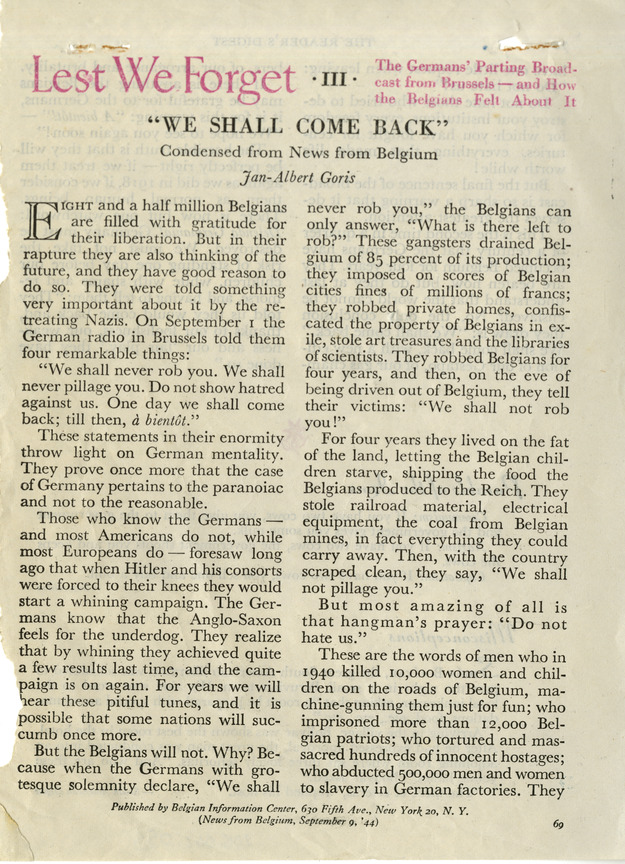
Insert 33a — Wednesday, February 7, 1945 (front)
Jan-Albert Goris, “We Shall Come Back,” “Lest We Forget” series, Part III, Reader’s Digest, Vol. 46, No. 273 (January 1945), pp. 69-70.
This article, condensed from an article printed in News from Belgium, 9 September 1944, described the liberation of Belgium and the last words of the Germans as they left that were broadcast from the German radio in Brussels. In the article, the author recorded the Germans as saying “We shall never rob you. We shall never pillage you. Do not show hatred towards us. One day we shall come back; till then à bientôt.” Goris contrasted this last message with the atrocities committed by the Nazis against Belgium during the war, and argued that the Germans already committed the crimes they claimed they would never commit. He briefly described the crimes committed by the Nazis and the numbers of Belgians that were abducted, imprisoned, and murdered during the war. He ended the article with a warning that if the Germans were treated the way they were after World War I, then their threat of returning to occupy Belgium again would become a reality.
For other articles in the “Lest We Forget” series, see Inserts 1 and 31.

Insert 33b— Wednesday, February 7, 1945 (front)
These are the fronts and backs (following post) of collectors’ cards from German cigarette cartons. These tiny cigarette cards (2” x 2.5”), as they were known, are fascinating cultural artifacts that were produced by German tobacco companies during the Weimar and Nazi eras, c. 1924-1939. They featured images and brief accounts of heroic German leaders and great moments in German history meant to rally the spirits of the German people during the dark days of the post-war era of the 1920s, and to inspire the people during the early years of the Third Reich. They also featured images of German movie stars and Native Americans to provide entertainment for Germans, and, most likely, to sell cigarettes. The cards, printed in color, were created in several differently-themed sets, such as “Postwar Times,” “From the Lives of the Indians,” “Colorful Movie Images,” “The Greatest Moments in World History,” and “Highlights of German History.” Cigarette card collecting was a popular hobby during this era, and Germans could display and enjoy their cards in the collectors’ albums sold by the tobacco companies. When completed, these albums provided Germans with images and stories of national greatness, past and present.
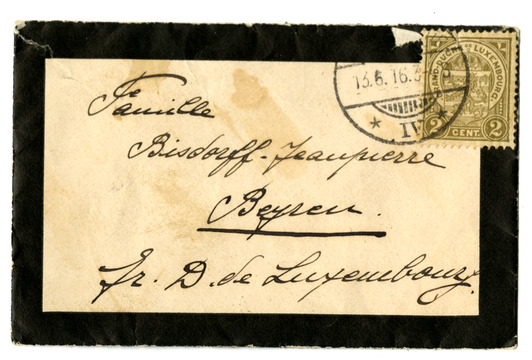
Insert 33c— Wednesday, February 7, 1945 (Front)
Insert 33d —Wednesday, February 7, 1945
“Famille Bisdorff-Jeanpierre/Beyren/ fr. D. de Luxembourg.”
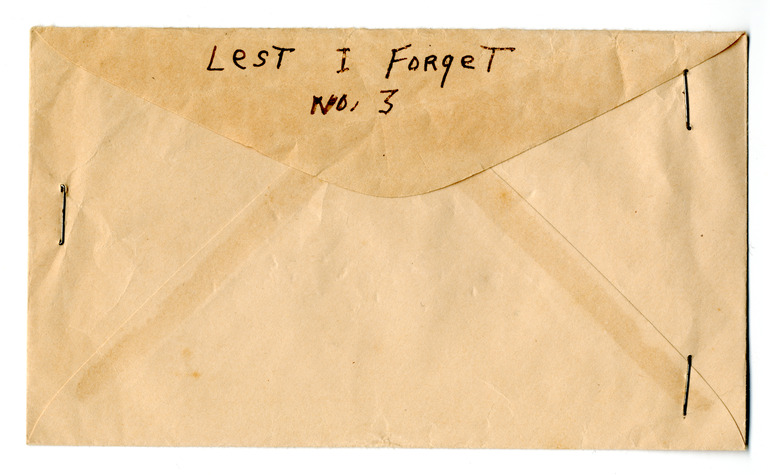
Insert 33d —Wednesday, February 7, 1945 (1)
Envelope in which the following unidentified photograph were stored. Goetz most likely acquired these photographs from abandoned houses and buildings occupied by his unit as it crossed through Germany.
The uneven printing on the envelope, characteristic of an older hand, suggests that Goetz labeled this envelope much later in his life when he was reorganizing his diary.
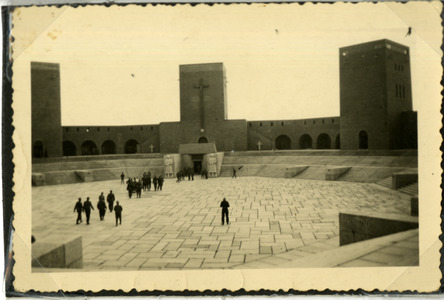
Insert 33d —Wednesday, February 7, 1945 (5)
Goetz did not identify the images in the photographs contained in the envelope. However, research reveals that this image is the Tannenberg Memorial, Hohenstein, East Prussia (now Olstynek, Poland) dedicated to German soldiers who lost their lives at the Battle of Tannenberg in World War I. The Memorial was destroyed at the end of the war.
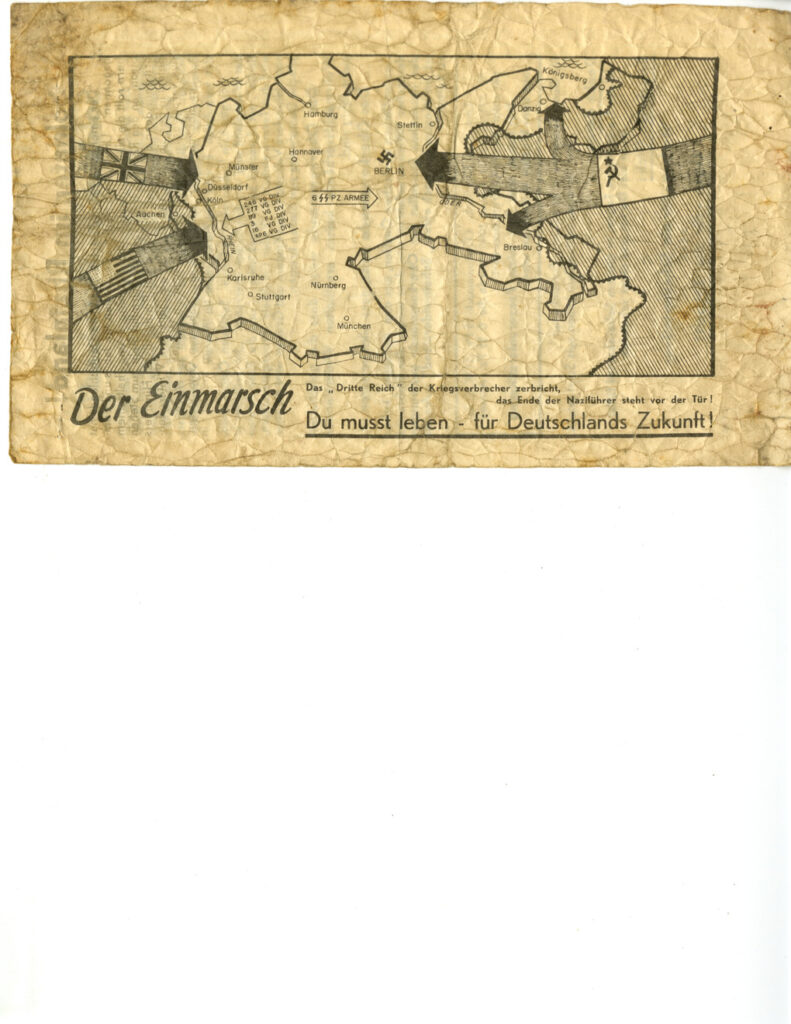
Insert 34— Friday, February 9, 1945 (front)
This is an Allied leaflet written by the Psychological Warfare Division of the Supreme Headquarters of the Allied Expeditionary Forces and disseminated by artillery shells by the First U.S. Army, October, 1944-May, 1945 (CT 46).
The leaflet, addressed to German soldiers, depicts Russian, British, and American advances into Germany, and urges the Germans to surrender. This leaflet, like the other two leaflets Goetz inserted into his diary, attempted to convince German soldiers to surrender. This leaflet attempted to instill fear and distrust of German leadership in the German soldiers by making a German defeat appear inevitable. During the last months of the war, when the war’s outcome appeared certain, the Allied leadership hoped to quickly end the fighting through the use of these leaflets. The Germans, however, continued their lethal assault on Allied troops and some of the most difficult and hard-fought battles of the war occurred during the final six months.
For other leaflets produced by PWD/SHAEF and attached to the Goetz diary, see Inserts 17b and 32.
The leaflet front (with map) reads: “The Invasion. The ‘Third Reich’ of war criminals breaks! The end of the Nazi Führer is at the door! You must live – For Germany’s future!”
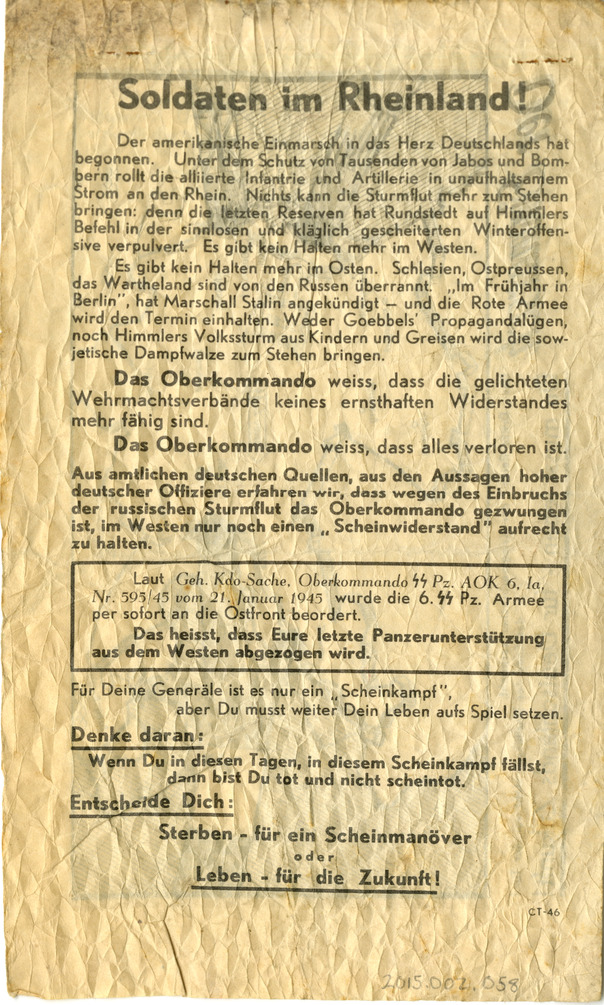
Insert 34— Friday, February 9, 1945 (back)
The leaflet back reads: “The American invasion in the heart of Germany has begun. The allied infantry and artillery roll into the Rhine under the protection of thousands of Jabos [fighter planes] and bombers in an unstoppable storm. Nothing can stop the flood: [Field Marshal] Rundstedt has spent the last reserves in the senseless and deplorable winter offensive on Himmler’s orders. There is no barrier in the west.
There is no barrier in the east. Silesia, East Prussia, and the Wartheland [captured Polish territory] are overrun by the Russians. “Springtime in Berlin,” Marshall Stalin announced – and the Red Army will keep that appointment. Neither Goebbels’ propagandist lies, nor Himmler’s militia of children and crude people will being the Soviet steamroller to a halt.
The Army Command knows that the thinned out armed forces are no longer a serious opposition.
The Army Command knows that all is lost.
The statements about the Russian storm flood by German officials compel the Army Command to erect a “blockade” in the west.
According to top-secret information from the command of the 6th Army Panzer Division, the 6th Panzer Army was ordered to the eastern front on 21st January, 1945.
That means that your last armored support in the west is drawn off.
For your generals, it is only a “false fight”, but you must further risk your life for this game.
Remember: If you fall during these days, in this false fight, you are dead, not false-dead.
Decide: Death – for a fake maneuver
or
life – for the future!”
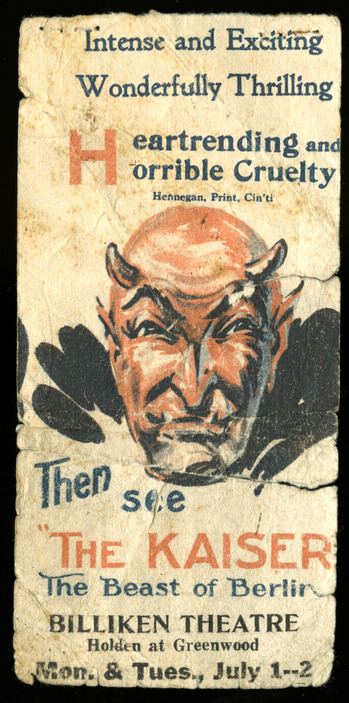
Insert 35— Saturday, February 10, 1945
Theater advertisement for the popular silent movie, “The Kaiser: The Beast of Berlin” written and directed by New Zealand native and prominent Hollywood director, Rupert Julian, in 1918. The Billiken Theatre (c. 1907‐1924) was a movie house popular in the silent‐movie era in Detroit.

Insert 35— Saturday, February 10, 1945
Theater advertisement for the popular silent movie, “The Kaiser: The Beast of Berlin” written and directed by New Zealand native and prominent Hollywood director, Rupert Julian, in 1918. The Billiken Theatre (c. 1907‐1924) was a movie house popular in the silent‐movie era in Detroit.

Insert 36a— Monday, February 12, 1945 (Front)
Cloth memorabilia for an exhibit of the robe of Jesus at Trier Cathedral. It reads: “In memory of the exhibit of the holy tunic of the Cathedral of Trier in the holy year of 1933.” This exhibit was held to mark the signing of the Reichskonkordat, the treaty designed to ensure the safety and free practice of Catholicism in exchange for disavowal of further political activity by clergymen. The treaty was a result
of negotiations between the Vatican and the newly‐installed Nazi government. Two million people visited the relic as part of the holy pilgrimage of 1933.

Insert 36b— Monday, February 12, 1945
A post card that reads: “Happy New Year! It is good that there are stops everywhere. Look out! Stops.” The “stops” alludes to the sign on the lamppost with the winged wheel indicating a railroad stop.
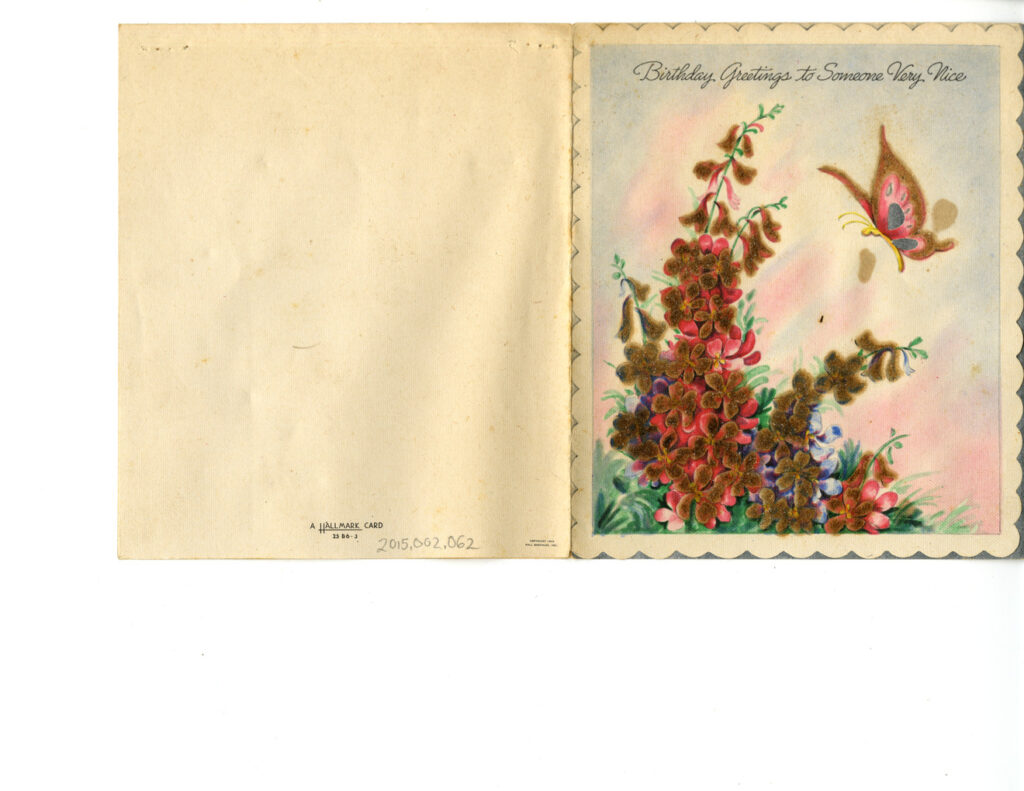
Insert 37a— Tuesday, February 13, 1945 (Outside)
A birthday card from Goetz’s fiancée and future wife, Mary.
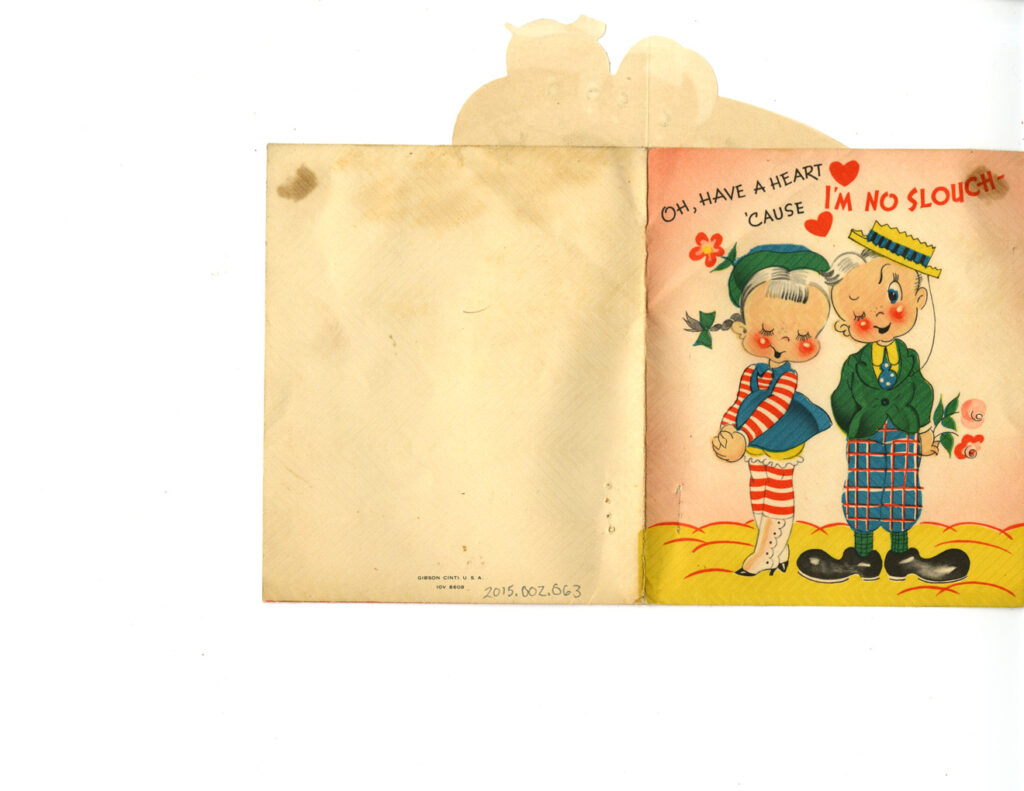
Insert 37b— Tuesday, February 13, 1945 (Outside)
A birthday card from a woman named Alice. She writes, “Remember me? I doubt it—probably too many French gals.”
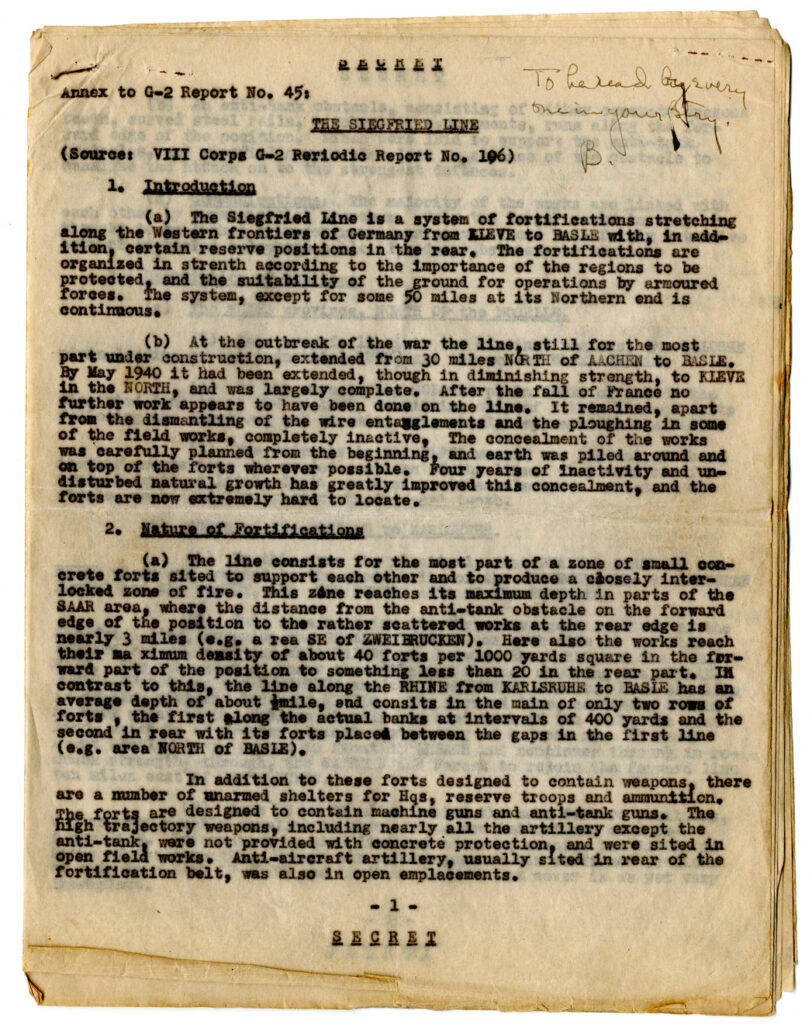
Insert 38 – December 13, 1944 (1)
Two pages of a 9-page typescript marked “Secret”, regarding the Allied assault on Germany’s heavily fortified “Siegfried Line,” which was intended to protect Germany’s western border, followed by “A German’s Advice to Americans and British” regarding America’s handling of the German army and people. Handwritten note on first page reads: “To be read by every one in your Btry./ B.”
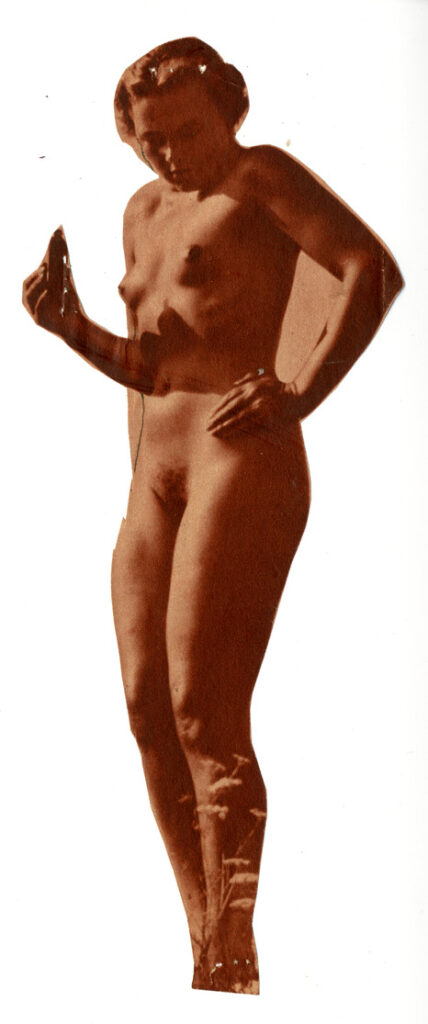
Insert 39— Tuesday, February 20, 1945 (right)
Two magazine cut-outs of naked women. When he attached them to his diary page, Goetz labeled the nude figures, “Two German Contributions to World Culture.”
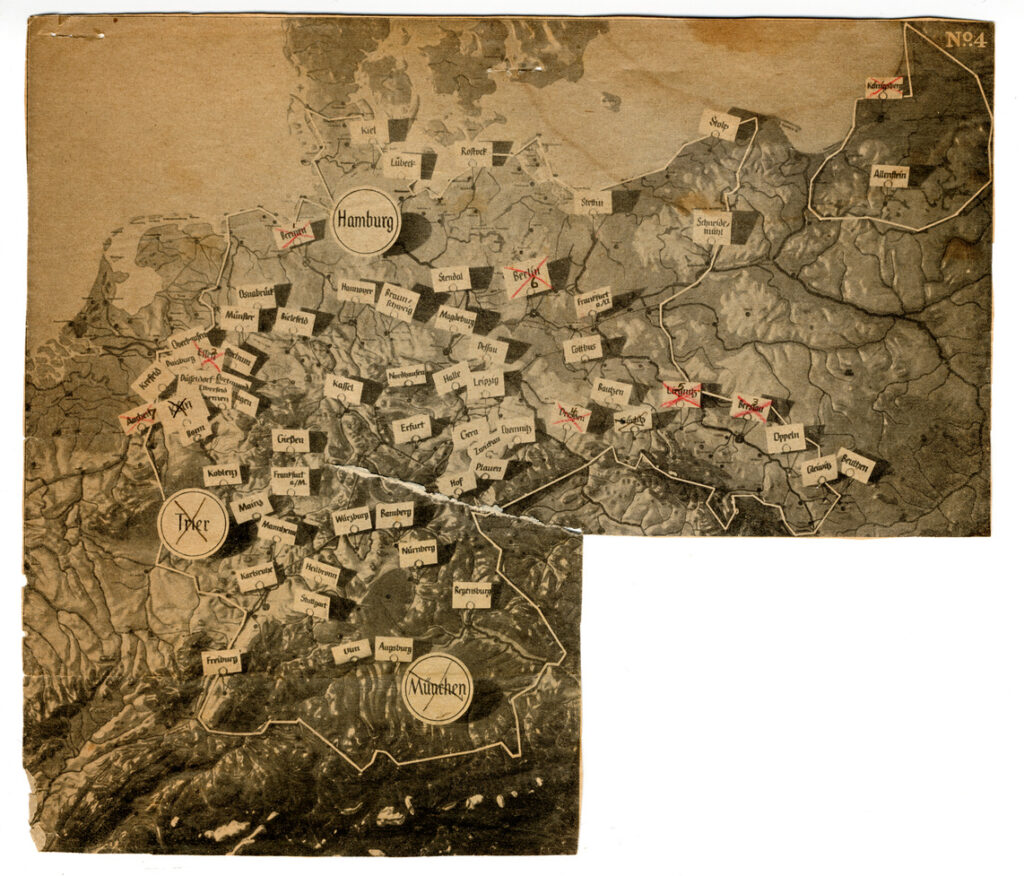
Insert 40— Thursday, February 22, 1945 (front)
Three quarters of an unidentified map of Germany, printed on newsprint, with names of cities crossed out.

Insert 40— Thursday, February 22, 1945 (back)
A photograph of a truck carrying a corpse through the ruins of a town—a scene witnessed over and over again by Vernon Goetz as his unit advanced through central Europe and into Germany.
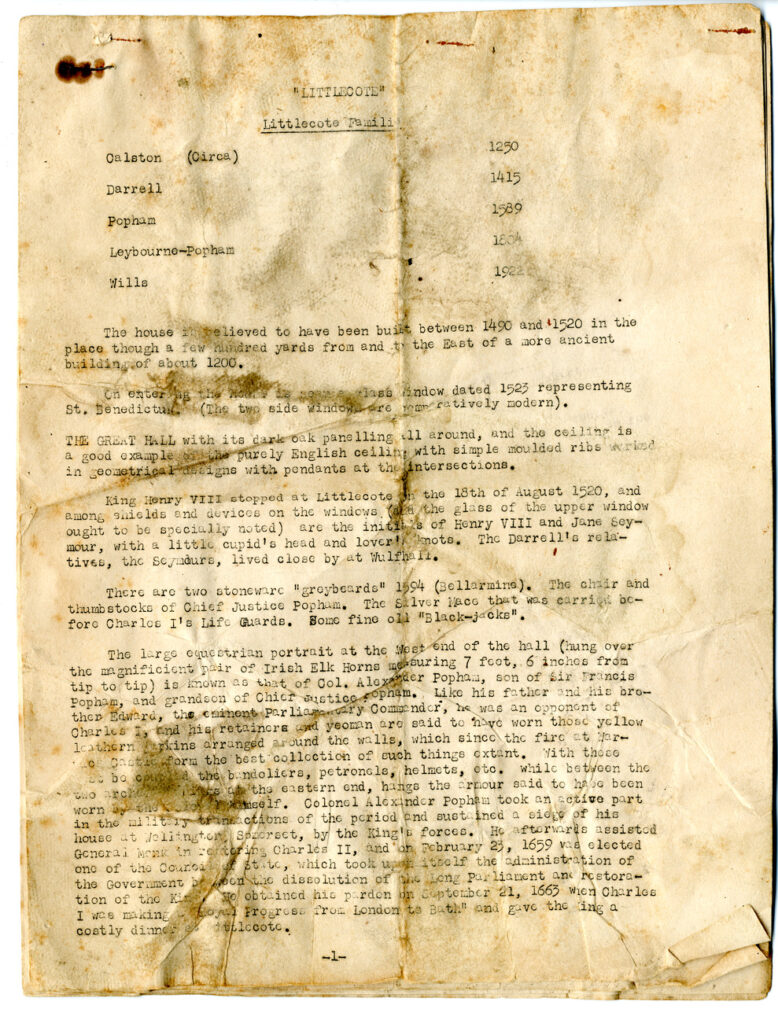
Insert 45— Tuesday, March 6, 1945
An official document, dated 24 February 1945, that indicates which soldiers have been returned to the U.S. “for Rehabilitation, Recuperation and Recovery.” Goetz’s friend, Donald Martin, is listed on this Special Order.
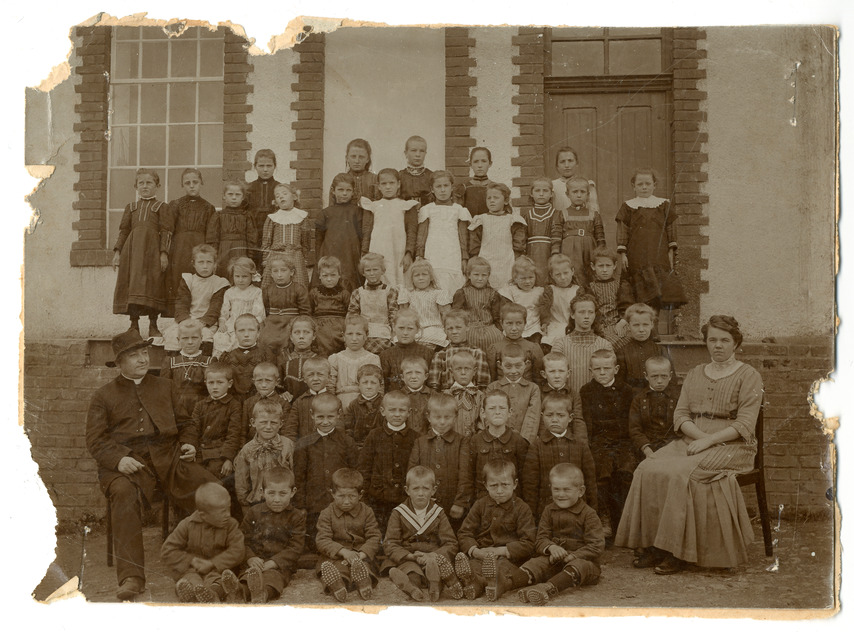
Insert 42— Monday, February 26, 1945
An unidentified black and white photograph of a group of children and two adults. This is possibly a photograph of a Sunday school class, ca. 1900.
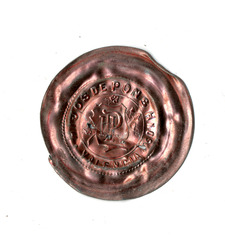
Insert 43— Wednesday, February 28, 1945
A seal from a bottle of brandy manufactured by Hijos de Pons, Valencia, Spain. Goetz attached the seal to his diary page with the notation: “From a Bottle of Captured Brandy.”
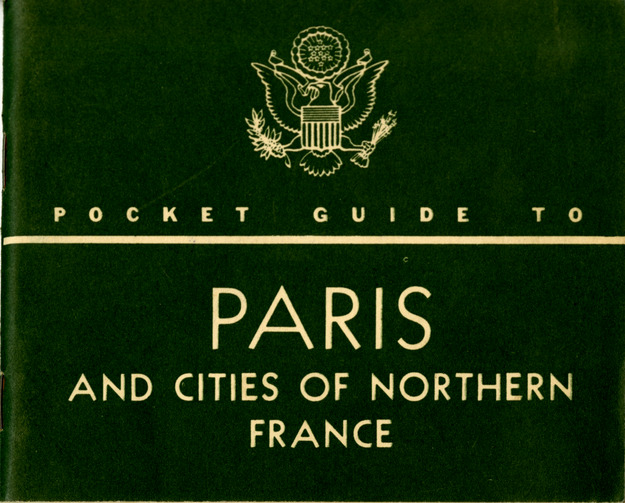
Insert 44— Friday, March 2, 1945
An 86‐page booklet, titled Pocket Guide to Paris and Cities of Northern France, published in 1944 by the
War Department and intended for military personnel. It contains small city plans and brief descriptions
of the history and major sites to be found in Paris and nineteen other French cities. The booklet invites
soldiers to sightsee, “so far as your military duties permit,” but warns that “the only thing in this booklet
that can be guaranteed is the terrain. The rest of it is up to the fortunes or misfortunes of war.” (pp. iii‐
iv) For a digital version of the entire contents of this booklet, see
http://digitalcollections.smu.edu/cdm/ref/collection/hgp/id/677
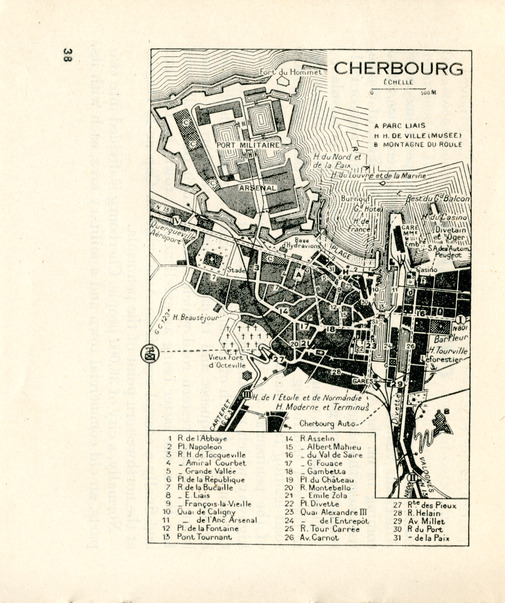
Insert 44 Back
An 86-page booklet, titled Pocket Guide to Paris and Cities of Northern France, published in 1944 by the War Department and intended for military personnel. It contains small city plans and brief descriptions of the history and major sites to be found in Paris and nineteen other French cities. The booklet invites soldiers to sightsee, “so far as your military duties permit,” but warns that “the only thing in this booklet that can be guaranteed is the terrain. The rest of it is up to the fortunes or misfortunes of war.” (pp. iii-iv) For a digital version of the entire contents of this booklet, see http://digitalcollections.smu.edu/cdm/ref/collection/hgp/id/677

Insert 45— Tuesday, March 6, 1945
An official document, dated 24 February 1945, that indicates which soldiers have been returned to the U.S. “for Rehabilitation, Recuperation and Recovery.” Goetz’s friend, Donald Martin, is listed on this Special Order.
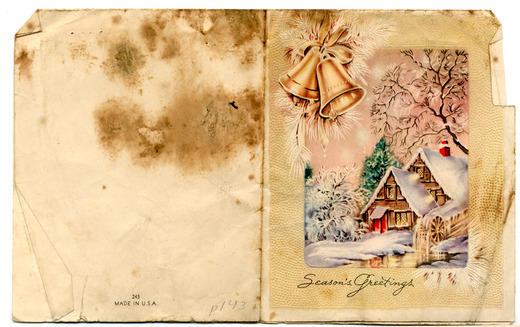
Insert 46— Thursday March 8, 1945 (Outside)
A greeting card from Goetz’s friend Robert F. Hertz. Cpl. Robert J. “Bob” Hertz was a good friend of Vernon’s in the Army. He served with Goetz in B Battery, 549th Anti‐Aircraft Artillery, 87th Division. He lived in South Carolina with his wife and
they kept in contact with Goetz and his wife, Mary, for many years. Interview with Mary
Goetz, April 14, 2014.
Goetz received this card from Hertz after the war. Goetz later attached this card to a page in his diary that was in close proximity to a diary entry (12 March 1945) that recorded a pleasant reunion between the two men in Lissendorf, Germany.

Insert 47a— Friday, March 9, 1945
A letter of commendation from Lt. Col. Thomas M. Larner, dated 8 March 1945, to Goetz’s “B” Battery, 549th AAA, Automatic Weapons Battalion, recognizing the unit for “exceptionally good” maintenance of their vehicles, and for the superior way in which they are performing their duties.
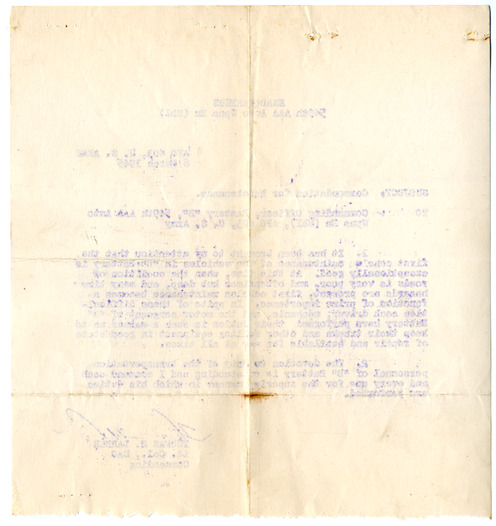
Insert 47b— Friday, March 9, 1945
A letter of commendation from Lt. Col. Thomas M. Larner, dated 8 March 1945, to Goetz’s “B” Battery, 549th AAA, Automatic Weapons Battalion, recognizing the unit for “exceptionally good” maintenance of their vehicles, and for the superior way in which they are performing their duties.
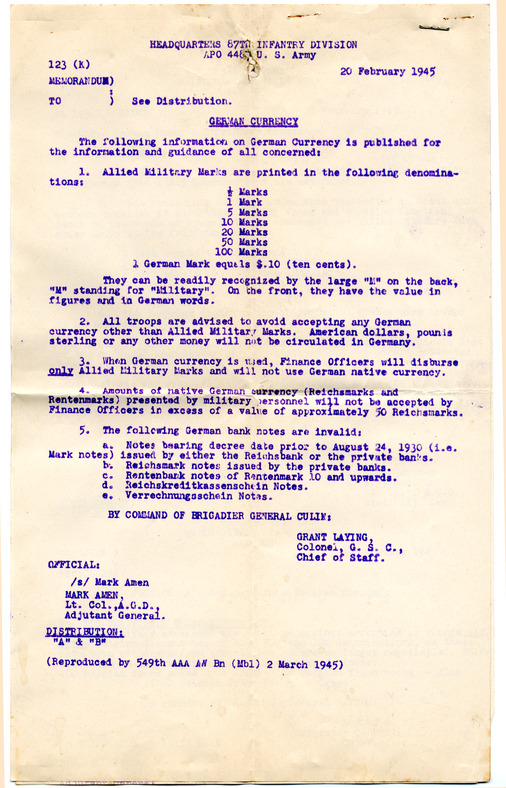
Insert 48a— Saturday, March 10, 1945
Memoranda from 87th Infantry Division Headquarters, dated 20 and 21 February 1945, concerning German currency and monetary exchange procedures.
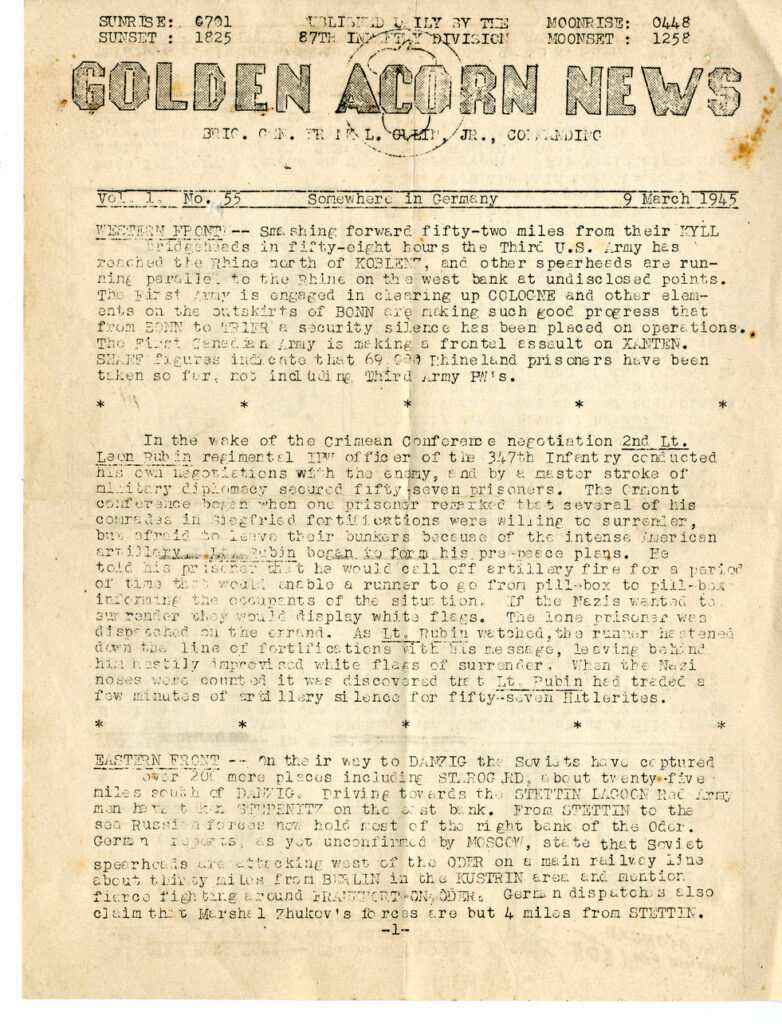
Insert 50a— Wednesday, March 14, 1945
An issue of the Golden Acorn News (Vol. 1, No. 55), March 9, 1945, titled “Somewhere in Germany.” The Golden Acorn News was the newsletter of the 87th Infantry Division, and it contained information and updates about the status of each theatre of combat. These newsletters were intended to be read and destroyed. The end of the newsletter ordered: “This paper, distributed to company level, is to be burned after the information has been passed on to all men of your command.”
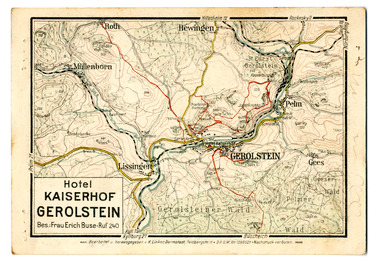
Insert 52a— Friday, March 16, 1945
A card from the Hotel Kaiserhof in the town of Gerolstein in the Rhineland-Palatinate region. One side of the card features a map of the area around Gerolstein, with the location of the Hotel Kaiserhof.
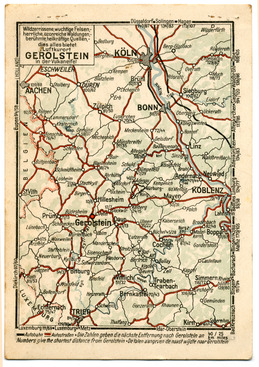
Insert 52b— Friday, March 16, 1945
The other side of the card features the larger region of eastern Germany that the proprietor praised for its many natural wonders.
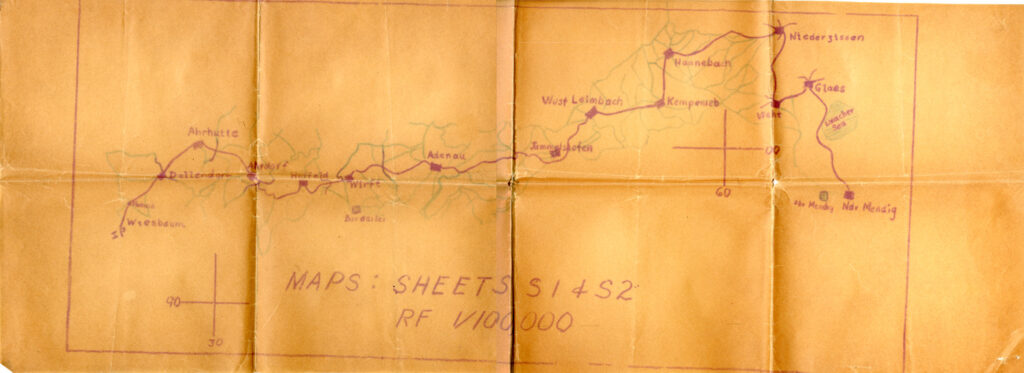
Insert 53— Saturday, March 17, 1945
A hand-drawn map (24”x 9”) indicating the route from Wiesbaum, a small town in Germany just east of the border with Belgium in what is today, Rhineland-Palatinate, through several small German towns, ending at Niedermendig, just west of Koblenz and site of the Mendig Airbase, which was captured by the Allies on March 14, 1945.

Insert 54a— Sunday, March 18, 1945
A post-war letter written to Donald (Tom) Ford from Dr. Ernst Waldemar Ittershagen of Frankfurt,Germany, dated 13 November 1947. The letter was written in response to a letter that Ford had sent, thanking Ittershagen for setting his broken leg during the war and inquiring about his fate during the difficulty post-war period in Germany. Dr. Ittershagen was a surgeon who worked at the hospital at Hohemark, which was attached to the POW camp, Stalag Luft III. Ittershagen pioneered the surgical procedure of using steel pins to set badly fractured legs, and Ford, an airman who had been severely injured in a plane crash in Germany in 1943, benefitted from his surgical innovation. In the letter, Ittershagen informs Ford that he still has the x-rays of his leg, “broken and nailed.” Ittershagen eventually sent those x-rays to Ford.
This poignant letter speaks to the suffering of the German people during the post-war era. Ittershagen was somewhat surprised that Ford seemed “to understand how badly we suffer at present under unpleasant living conditions. . . . I have a family of 6 to support, three little ones and my wife’s sister—a tough job in such times.” He then embraces Ford’s offer of assistance: “I would greatly welcome and appreciate your offer of a package.”
In the postscript, Ittershagen mentioned Hanns Scharff. During the war, Hanns-Joachim Gottlob Scharff (1907-1992) was a highly successful interrogator for the Luftwaffe who was also well-liked by the POWs. His marriage to a British woman may have accounted for his “Limie-accent.” After the war, Scharff moved to the United States where he presented lectures to the Air Force and Army on his interrogation techniques. Beginning in the 1950s, he turned his attention to art and became well-known for his mosaic designs. Scharff’s designs are featured in numerous locations in the United States, including the Los Angeles City Hall and the Cinderella Castle at Walt Disney World, Florida.
Donald (Tom) Ford (1920-2015) grew up together with Vernon Goetz in Aberdeen, Maryland. They remained friends throughout their lives. At some point after the war, Ford shared this letter with Goetz and allowed him to keep it. Interview with Donald (Tom) Ford, 17 September 2014, Goucher College Special Collections and Archives; Marilyn Jeffers Walton, Rhapsody in Junk: A Daughter’s Return to Germany to Finish Her Father’s Story (Bloomington, Indiana, 2007). E-Book.

Insert 54b— Sunday, March 18, 1945
German staff and American POWs at Hohemark Hospital near Oberursel, Germany. Donald Ford is standing, second from the left, next to Dr. Ernst Ittershagen. https://stalagluft3.wordpress.com/2015/09/
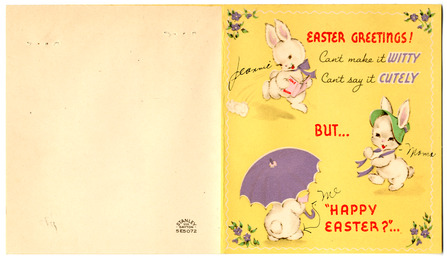
Insert 55a —Monday, March 19, 1945
A small Easter greeting card with a personal note inside that says “Love from all of us – ‘The Big 3’.”
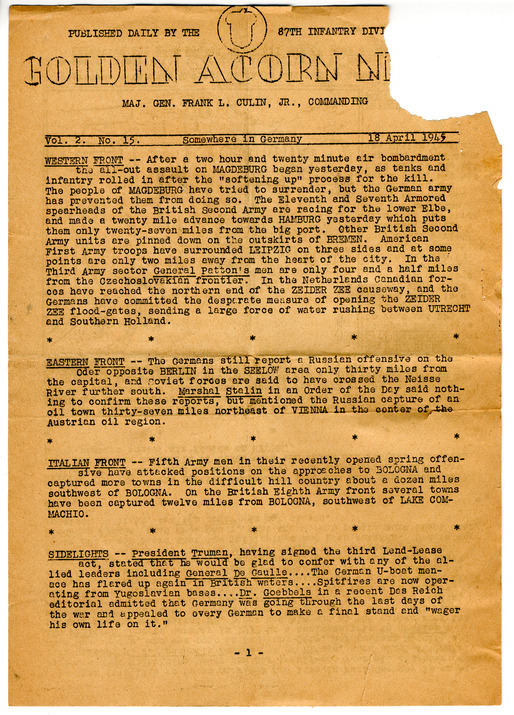
Insert 57a— Wednesday March 21, 1945
An issue of the Golden Acorn News (Vol.2, No. 15) titled “Somewhere in Germany.” The issue is dated April 18, 1945. This issue contains information and updates about the status of various theaters of combat as well as news about the 87th Division.

Insert 58— Friday, March 23, 1945
Article written by Sgt. Robert McBrinn, staff correspondent for the military newspaper Yank, titled “Coblenz was Different.” The article calls attention to the fact that the Third Army capture of the town of Coblenz in Germany represented the second time in the twentieth century that the Third Army had occupied the town. During World War I, the Third Army had also invaded “this German resort on the Rhine.” The article details memories of soldiers and journalists about the major features of the town during the first World War, and about the very different combat experiences in Coblenz during the two wars. Once inside the town, according to McBrinn, “there wasn’t much to remember. The avenues and streets down to the river front were littered with rubble. The city that was once the social center of the occupation army was ground to brick dust in many places, and the German artillery and mortar from across the river were completing the chaos.” The 87th Infantry Division, to which Goetz’s unit was attached, led the attack on the city.
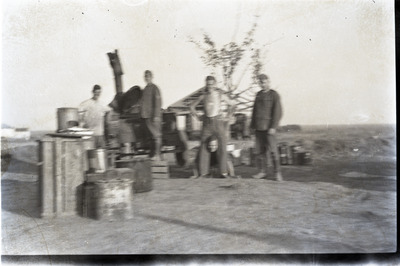
Insert 59a—Saturday, March 24, 1945
Images of German soldiers taken from photo negatives that Goetz inserted into his diary. For more photographs of German soldiers, see the German War Photographs page.
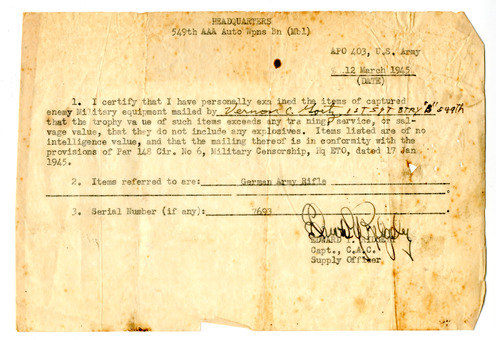
Insert 60a (front)—Sunday, March 25, 1945
A military protocol form certifying that Vernon C. Goetz complied with the instructions as per the military, concerning the mailing of a German army rifle that was considered to be “captured enemy Military equipment.” The form is dated March 12, 1945.
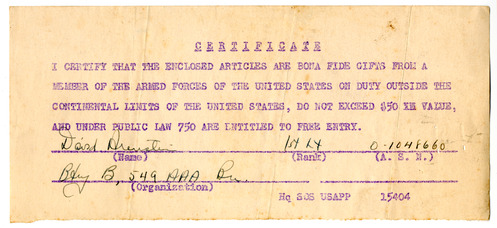
Insert 60b(front)—Sunday, March 25, 1945
There are also two small certificates in blue ink that are possibly signed by the person to whom Goetz gave the rifles. The forms say that the signer recognizes that the articles were sent from a member of the armed forces and comply with military protocol for mailing items.
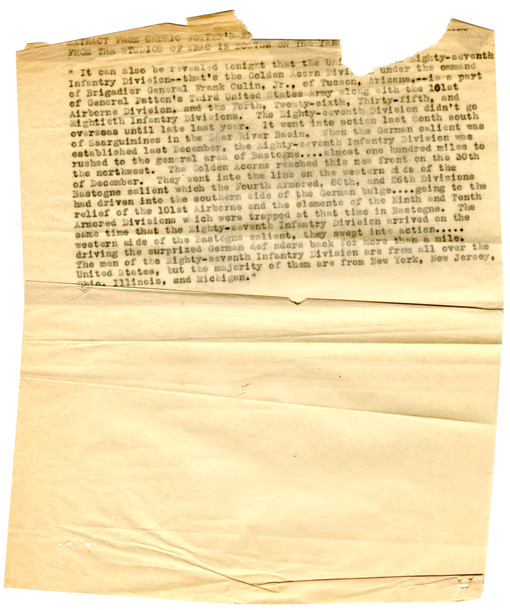
Insert 61 – Saturday, April 14, 1945
A military protocol sheet that faintly reads “Extract from Cedric Foster’s…” (the rest is torn). The next line says that the paper is from the studios of the radio station WNAC in Boston. The paper is weathered and wrinkled and most of the text is very unclear, but the paragraph appears to detail the exploits of the 87th Division throughout the war.
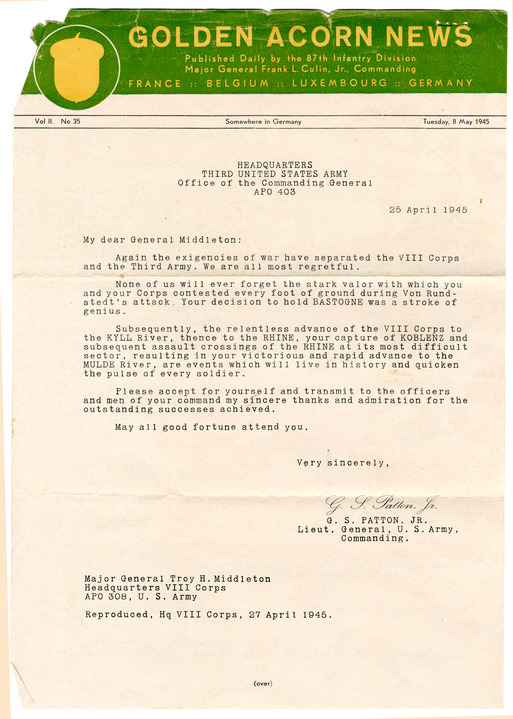
Insert 62a—Monday, April 16, 1945
Golden Acorn News from May 8, 1945 that contains a letter from General Patton to General Middleton. The letter is dated April 25, 1945 and shows Patton’s appreciation and recognition of the work done by the Third Army and the VIII Corps during the war. The back of this letter shows Middleton’s correspondence and thanks to those serving alongside him.
